List of Abbreviations
ACE Assessment, Case Management and Evaluation
AD:EPT Alcohol and Drugs: Empowering People through Therapy
APs Approved Premises
BASS Bail Accommodation and Support Service
BITC Business in the Community
BMC Belfast Metropolitan College
CJB Criminal Justice Board
CJI Criminal Justice Inspection (Northern Ireland)
CPO Community Payback Order
DfC Department for Communities
DoH Department of Health
DoJ Department of Justice
ECO Enhanced Combination Order
EM Electronic Monitoring
GPS Global Positioning Systems
HMIP His Majesty’s Inspectorate of Prisons
HMPPS His Majesty’s Prison and Probation Service
HR Housing Rights
HSC Health and Social Care
IOM Integrated Offender Management
IRC Independent Reporting Commission
MHC Mental Health Court
MoJ Ministry of Justice
NI Northern Ireland
NICS Northern Ireland Civil Service
NICTS NI Courts and Tribunals Service
NIHE Northern Ireland Housing Executive
NILC Law Commission for Northern Ireland
NISRA Northern Ireland Statistics and Research Agency
NIPS Northern Ireland Prison Service
NPS National Probation Service
NWRC North-West Regional College
OBA Outcomes Based Accountability
ODPs Outcomes Delivery Plans
OECD Organisation for Economic Cooperation and Development
PASS Presumption Against Short prison Sentences
PBNI Probation Board for Northern Ireland
PDM Prisoner Development Model
PDP Personal Development Plan
PDU Prisoner Development Unit
PfG Programme for Government
PND Penalty Notices for Disorder
POST Positive Outcomes for Short-Term Prisoners
PPANI Public Protection Arrangements for Northern Ireland
PPS Public Prosecution Service
PSJ Problem Solving Justice
PSNI Police Service of Northern Ireland
PSR Pre-Sentence Report
ROD Reducing Offending Directorate
RoI Republic of Ireland
ROP Reducing Offending in Partnership
RRSOG Reducing Reoffending Strategic Outcomes Group
SEHSCT South Eastern Health and Social Care Trust
SLA Service Level Agreement
SMC Substance Misuse Court
TEO The Executive Office
UK United Kingdom
VCS Voluntary and Community Sector
YJA Youth Justice Agency
Key Facts
Offending and Reoffending
Approximately 31,000 offenders convicted in court or given an out-of-court disposal each year.
16% of adult offenders reoffended within one year in 2019-20.
10,000 reoffences committed by 3,000 adults in 2019-20 (more than 3 offences per reoffender).
Strategy and Costs
10 years since the Strategic Framework for Reducing Offending was published in 2013.
£16.7 billion annual estimated economic and social costs of adult reoffending in England and Wales. An equivalent estimate for Northern Ireland is unavailable.
£16.1 million direct annual funding for rehabilitation initiatives across both custodial and community settings.
The Prison Population - Short-term prisoners
77% of sentenced prisoners committed in 2021-22 received custodial sentences of 12 months or less.
52% of short-term prisoners reoffended within one year of release in 2019-20.
The Prison Population - Remand prisoners
37% of the prison population were held on remand in 2021-22.
1,300 individuals committed to remand in 2020 did not ultimately receive a custodial sentence.
Key Challenges to Rehabilitation
Accommodation
16% of prisoners were released from custody in 2019-20 with no identified accommodation.
Education and Employment
74% of prisoners in 2022 had left school at age 16 or under, and 32٪ had no qualifications.
Mental Health
45% of offenders assessed by PBNI between 2017-21 had some level of mental health issues which contributed to their offending.
Substance Misuse
66% of prisoners in 2022 reported having used drugs at some stage in their life.
Executive Summary
Background
1. The justice system aims to protect the public, bring offenders to justice, and support their subsequent rehabilitation to reduce overall offending levels. Within this, the Department of Justice (‘DoJ’ or ‘the Department’) formulates policy and oversees the strategic framework for several statutory bodies, principally the Northern Ireland Prison Service (NIPS) and the Probation Board for Northern Ireland (PBNI), who work closely with the voluntary and community sector (VCS) in delivering various rehabilitation programmes and initiatives.
2. Around 100,000 crimes are reported to the Police Service of Northern Ireland (PSNI) each year. As a result, 24,000 people are convicted in court of criminal offences, with 3,000 offenders receiving a custodial sentence, served in one of Northern Ireland’s prisons, managed by NIPS. Similarly, around 3,000 offenders receive a supervised community sentence which, for adults, is managed by PBNI, which is also responsible for the post-custody supervision of around 500 adult prisoners upon their release each year.
3. Many individuals are reoffenders, trapped in a cycle of offending without making effective progress towards rehabilitation. DoJ’s most recent statistics show that 16 per cent of adult offenders reoffended within one year, with further analysis revealing that 46 per cent of adults who completed a custodial sentence reoffended within one year of release, whilst 29 per cent of adults subject to community supervision also reoffended.
4. Multiple factors, including age and gender, influence offending behaviour. People who encounter the justice system frequently tend to live disorderly lives and have significant mental health, alcohol and substance abuse issues. Homelessness, poor educational attainment and employment opportunities, and psychological issues also contribute. In addition, the unique context of Northern Ireland and the Troubles undoubtedly has a significant impact. These factors mean that managing and supporting the rehabilitation of these prolific offenders is complex and problematic.
5. Reoffending impacts significantly on society. A conservative estimate of its total annual economic and social cost in England and Wales is £18.1 billion, £16.7 billion of which relates to adult reoffenders. Similar estimates are unavailable in Northern Ireland (NI), but the figure is likely to be significant. These individuals and their families require access to effective support services to aid their rehabilitation and break their cycle of offending.
6. Reducing reoffending was first identified as a key Programme for Government (PfG) area within the draft 2016-2021 document (Outcome 7), with the reoffending rate included as one of the draft indicators (Indicator 39) intended to help monitor progress towards achieving this. Following the Executive’s collapse in January 2017, the Northern Ireland Civil Service (NICS) assumed responsibility for developing Outcomes Delivery Plans (ODPs) to oversee the delivery of actions that supported the strategic direction set by the former Executive’s draft framework of outcomes. In relation to reoffending, the plans focused particularly on employment and delivering various `Problem Solving Justice’ (PSJ) initiatives.
7. Our report identifies that, although there are some positive trends in offender numbers and reoffending levels, there continue to be systemic issues that impact on the ability of the justice system to rehabilitate a core group of prolific offenders. Undoubtedly, there have been other good developments, particularly in relation to some pilot projects which appear to have had positive impacts, but financial constraints and prioritisation of Covid recovery mean that they have not yet been fully evaluated and rolled out.
Key Findings
DoJ is aware of the key factors that impact on reoffending, and has been developing a greater focus on desistance and rehabilitation
8. The Department is well sighted on the principal factors that influence whether someone reoffends after an initial conviction. These include:
- family life and relationships;
- mental and physical health needs;
- substance and alcohol dependence;
- accommodation; and
- employment opportunities.
It has developed a range of measures over the last decade which seek to address these factors, and which place a strong focus on desistance (i.e. the premise that offenders can develop and change in the right circumstances) and rehabilitation.
9. Evidence indicates that this approach has enjoyed a degree of success. Prisoner numbers are the lowest per population head in the United Kingdom (UK), and overall the number of offenders and reoffenders has reduced during the period 2013-14 to 2019-20, from 25,164 to 19,344 (23 per cent) and from 4,353 to 3,098 (29 per cent) respectively. Significantly, the most recent data for 2019-20, published in November 2022, revealed the lowest adult reoffending rate in NI (16.0 per cent) in almost a decade. Prior to this, the rate had stagnated at around 17 to 18 per cent. Whilst positive, some caution must be exercised over this recent trend as the COVID-19 pandemic may have influenced these statistics, due to reduced freedoms and the associated impact on court activity.
10. Further analysis would be significantly assisted by comparison of NI performance with other jurisdictions. However, this is not currently feasible, given differing measurement systems and techniques across the UK and the Republic of Ireland (RoI), and limited resources to undertake complex benchmarking work.
To address a remaining cohort of prolific offenders, enhanced strategic direction and accountability is required to advance the justice sector’s rehabilitation work
11. The draft PfG 2016-2021 was the first time that the Executive had established reducing reoffending as a key strategic area for government. In May 2017, DoJ subsequently established the Reducing Reoffending Strategic Outcomes Group (RRSOG) to provide strategic direction, oversight and monitoring of progress towards reducing reoffending rates to meet the PfG objective. Whilst a positive development, the RRSOG membership decided at an early stage that an updated cross-cutting or formal strategy for reducing reoffending was not required. A commitment to develop a short strategic narrative was also deferred in June 2019, in the absence of a functioning Executive at that time.
12. In our view, the decision not to develop an overarching strategy, aligned with the Department’s commitments under the draft PfG framework of outcomes, represented a missed opportunity to better address the issues which influence reoffending. This was heightened by weaknesses in the oversight and reporting arrangements for the group, in particular the absence of a formal link with the Criminal Justice Board (CJB), which includes representation from wider justice partners such as the judiciary, the NI Courts and Tribunals Service (NICTS) and the Public Prosecution Service (PPS).
13. The Department told us that its Strategic Framework for Reducing Offending, published in 2013, remains fit for purpose. However, in our opinion, it does not take account of significant strategic issues facing the justice system in more recent times, such as the high levels of short-term and remand prisoners. Further, monitoring against this Framework and a subsequent 2015 Desistance Strategy ceased in 2016, without formal evaluation of their implementation or effectiveness.
14. We consider that a more definitive strategic direction, identifying and prioritising the main actions, targets and expected outcomes, would likely have assisted further reductions in adult reoffending and left the statutory bodies better placed to target resources at the highest risk groups, which current statistics show to be young, male and prolific offenders of acquisitive crimes (burglary, robbery and theft). Going forward, a strengthened strategic approach to adult reoffending, and to this cohort in particular, is required if further reductions in the reoffending rate are to be achieved.
A stronger focus is also required on what reoffending costs society in NI and the expenditure the justice sector incurs on offender rehabilitation
15. Although the total annual estimated economic and social cost of adult reoffending in England and Wales is £16.7 billion (paragraph 5), DoJ is currently unable to estimate the equivalent costs for NI. In addition, whilst NIPS and PBNI incur approximately £16.1 million each year directly on interventions to support offender rehabilitation, DoJ is unable to disaggregate the wider indirect spend on reducing reoffending across the justice system. It is therefore not possible to produce a wholly reliable estimate of total expenditure on reducing adult reoffending.
16. This key gap in management information means the Department is unable to effectively assess, on an ongoing basis, the financial and strategic landscape it operates in, and whether the investment made by the justice sector in trying to reduce reoffending is a proportionate or sufficient response to the scale of the problem.
NI has high numbers of short-term and remand prisoners, but their access to rehabilitation and support services is limited
17. Over three quarters of custodial sentences bestowed by the courts are short-term (12 months or less), and around 27 per cent of the sentenced daily prison population in NI in 2021-22 comprised short-term prisoners. This significantly exceeds levels in Scotland and in England and Wales, which recorded approximately 18 per cent and 5 per cent respectively in the same period.
18. Short prison sentences can significantly disrupt offenders’ lives and their families and, crucially, can hinder rehabilitation through prisoners losing employment, housing or family contact. Offenders therefore often leave prison in poorer circumstances than when entering and, as a result, can be impacted far beyond the punishment intended by the court. Such offenders are entitled to access rehabilitation services whilst in custody, but the short period spent in prison often means there is limited scope for doing so. The consequences are clear, with short-term custodial sentences linked to higher reoffending rates. In 2019-20, 52 per cent of local custody releases who spent less than 12 months in prison reoffended. For supervised community orders, during the same time period, the corresponding reoffending rate was 29 per cent.
19.Criminal Justice Inspection Northern Ireland (CJI) has repeatedly commented that rehabilitation services for short-term prisoners have been at best inconsistent, and otherwise insufficient. To try and address gaps in support, NIPS introduced the Positive Outcomes for Short-Term Prisoners (POST) project in June 2016 in conjunction with NIACRO (an organisation which supports offenders). POST aimed to support purposeful activity and offered assistance across housing, literacy, employability and skills, with CJI stating that such a programme was “long-overdue”. However, a 2019 evaluation was unable to conclude whether it was effective in achieving its aim of encouraging desistance but found that the service was lacking in many aspects, indicating that there remains significant scope for improvement in support for this group.
20. Local short-term prisoners are not subject to post-custody supervision upon release and few support services are available to those transitioning to community life after a short-term sentence. Significant resettling difficulties can therefore be encountered, which increases the risk of reoffending, particularly in the three-month period post-release. Our research identified that ‘through the gate’ support is more advanced across the rest of the UK, where various initiatives have been operating since 2015.
21. NI also has a far greater proportion of remand prisoners than other UK jurisdictions. The proportion of such prisoners has risen sharply locally, from under 25 per cent in 2015-16 to 37 per cent in 2021-22. This compares with 25 per cent in Scotland and 17 per cent in England and Wales. Issues with the legislative and policy framework in NI are likely contributing to these high numbers. Bail laws, for example, are not enshrined in a specific piece of legislation as in other UK jurisdictions, despite this being recommended by the Law Commission for Northern Ireland (NILC) in 2012, whilst repeated CJI recommendations for legally binding time limits to court cases, to help reduce avoidable delay and lower remand levels, also remain unimplemented.
22. The judiciary told us that inadequate bail support services, which would provide assurance that reoffending risks could be appropriately managed in the community, mean remand often becomes the preferred option when considering bail applications, as this assurance cannot be provided to the court at the time of the first appearance when bail is being considered. To further complicate matters, NI has no formal bail information scheme to provide judges with timely access to the information required to grant bail, including an individual’s circumstances and offending history. Again, both were recommended by the NILC in 2012. As a result, NI is currently significantly behind established bail practices in other UK jurisdictions.
23. NIPS, which is key to supporting rehabilitation, has limited scope to work with remand prisoners as, in many cases, they have not actually been convicted of any offence. A significant proportion, particularly those who are later convicted and released due to ‘time served’, therefore do not avail of rehabilitation support whilst in custody and this, combined with the effects of prison detention on accommodation, employment and family relationships, increases reoffending risks. The uncertainty surrounding remand release dates also conflicts with housing system processes and contributes to difficulties securing accommodation for discharge. This hinders access to other resettlement services requiring an address, including GP registration, opening new bank accounts or applying for benefits.
The Department has taken a number of initial steps to develop viable alternatives to short-term sentences and better address the needs of specific groups of reoffenders, but progress has stalled and meaningful work to address remand issues is at very early stages
24. Although formal assessment of the overall costs of short-term sentences and remand, compared to their alternatives (community orders and bail), has not been completed, both custodial options are accepted as being more expensive. Reducing overall numbers therefore has the potential to deliver significant cost savings, alongside improved reoffending outcomes.
25. In part recognition of this, the Department has introduced a range of ‘Problem Solving Justice’ (PSJ) pilots in recent years which aim to address the root causes of offending behaviour and provide meaningful and viable community-based alternatives for the judiciary when sentencing. The most significant of these is the Enhanced Combination Order (ECO), which was first introduced in October 2015 in the Ards, and Armagh and South Down court areas, and later extended to the North-West in October 2018.
26. The ECO focuses on restorative practice, desistance and victims, with offenders also completing unpaid community work, and being referred for mental health, behavioural or family support, as appropriate. Non-compliance results in offenders being returned to court and potentially sentenced to custody. Three evaluations have reported positive findings on the pilot, including potentially significant annual economic benefits (£5.7 to £8.3 million) arising from full roll-out, but no further expansion has followed since 2018, primarily due to funding constraints. The Department now needs to assess the merit of full introduction across the remaining local court areas.
27. The Department announced a Sentencing Policy Review in mid-2016 which had the potential to help address issues around short-term sentencing. Following a process of planning and public consultation, in April 2021 it published a series of recommendations, highlighting strong support for the increased use of community disposals as an alternative to short-term prison sentences, and committing to consider in more detail a potential suite of new options. However, such change requires legislative action and, whilst preparatory work has commenced, it is a significant piece of work. Once this is completed and the legislation drafted, subsequent progress may be further impacted if there is not a functioning Assembly.
28. DoJ has not yet progressed several other PSJ initiatives to full implementation. The Substance Misuse Court (SMC) pilot was introduced in Belfast Magistrates’ Court at Laganside in April 2018. It places offenders on intensive treatment programmes, under court supervision, to specifically target drug and alcohol linked offending behaviour, with final sentencing reflecting their participation. Evaluations have indicated that those successfully completing the programme exhibited lower longer-term reoffending rates than those who did not, resulting in the SMC programme being embedded into the normal rostered business at Laganside from April 2021. Despite this apparent success, the development of a plan for wider roll-out, to be implemented in 2022-23, was not achieved due to budgetary constraints. In our view, however, relatively low participation and completion rates indicate that further consideration of the initiative is required to inform roll-out, including an assessment of its cost-effectiveness.
29. A Mental Health Court (MHC) pilot, which in theory would see offenders with mental health issues receive treatment while being subject to proceedings, was expected to deliver similar benefits but did not commence, with DoJ, in conjunction with the Department of Health (DoH), now currently trying to identify alternative approaches.
30. The Department told us that budgetary constraints and prioritisation of Covid recovery have prevented further progress in piloting, assessing, or rolling out these PSJ initiatives, and our review also noted similar problems with several other offender rehabilitation projects. DoJ now finds itself at an impasse, unable to confirm what the future of PSJ looks like, and whether these initiatives will be rolled out further.
31. In November 2022, the Department established a justice-wide remand working group to consider the options available to address the excessively high remand levels in NI. The increased focus on this area is a welcome development, albeit long overdue. Going forward, it will be incumbent on the Department to establish effective monitoring arrangements for the work of this group to ensure that the current momentum is maintained.
Improved cross-government working is needed to secure improvements across key desistance pathways including accommodation and mental health
32. Reducing reoffending is complex and involves many different parts of government. Preventive measures, such as stable family environments and accommodation, educational attainment, financial security and employment, and physical and mental health, all sit outside the scope of the justice system. The wide number of variables at play, many of which fall outside DoJ’s remit, and a continuously reducing justice budget, means the Department is operating in an extremely challenging environment.
33. Although DoJ has led, or contributed to, some good collaborative initiatives aimed at improving offender outcomes across desistance pathways, particularly employment (paragraph 6), greater partnership working across government is required if real and sustainable change is to be delivered. Such arrangements had been envisaged by the draft 2016-2021 PfG but have fallen short because of alternative or competing priorities amongst partners within a severely pressured financial environment. Our stakeholder engagement highlighted that improvements are required, predominantly in areas such as accommodation and mental health, where poor or complex interfaces between these systems and justice act as significant barriers to resettlement.
34. Securing the required ‘buy in’ from other NICS departments to support collaborative working will prove difficult, given their own tight financial constraints. This is particularly the case given that improved cross-departmental processes, governance structures and reporting lines will also inevitably require significant upfront investment from the public purse. A new PfG, when introduced, may offer an opportunity to address some of these issues.
Work is required to develop an outcome measurement framework that underpins the PfG and the key justice-led indicators
35. Evaluation evidence indicates individual reoffending programmes and interventions can impact positively on outcomes, and this has perhaps contributed to the recent reduced reoffending rates (paragraph 9). However, in the absence of a well-defined strategic focus (paragraphs 11 to 14) which assesses the respective performance of these collectively, there is insufficient clarity on which measures are achieving greatest impact and need to be further supported, or which perhaps should be discontinued. This is important in maximising benefits in times of such finite resources.
36. Within DoJ, enhanced performance measurement and targets to monitor success in reducing the reoffending rate are clearly required. This view is shared by CJI, which has repeatedly highlighted the need for improved performance measures that indicate achievement of longer-term outcomes, to allow management to assess effectiveness of service provision and plan future delivery and resourcing.
37. Improved information will also enable the Department to understand more fully the impacts being generated from this aspect of its work. Currently, local systems do not capture all the data needed to measure wider outcomes, and progress is constrained by inadequate integration of systems and restrictions on data sharing. As paragraphs 15 and 16 noted, DoJ also does not know the cost of reoffending or what it spends trying to reduce it. These are key information gaps which mean that, overall, DoJ is unsighted on whether its investment in reducing reoffending is cost effective in delivering improved outcomes.
38. Existing information could also be strategically analysed better to inform policy and further decision-making. An important example of this is the Assessment, Case Management and Evaluation (ACE) methodology that PBNI uses to assess individuals’ reoffending risk. Whilst it is used to inform sentencing and case management at individual offender level, it is not routinely analysed cumulatively to assess the impact of specific interventions or better inform future strategy and resourcing. PBNI told us that it is currently exploring other, more sophisticated, risk assessment tools with potentially increased validity for this purpose.
Conclusions
39. Whilst the recent reduction in the reoffending rate may have been impacted by the COVID-19 pandemic, wider longitudinal trends, such as falling offender and reoffender numbers, indicate that some of the current interventions may be having a positive impact. It should also be acknowledged that staff within the statutory organisations, and VCS partners, have continued delivering critical frontline services during the pandemic and against extremely challenging financial constraints.
40. However, meaningful comparison of reoffending rates with other UK and RoI jurisdictions is not feasible due to the various jurisdictions measuring and reporting outcomes differently, and more work is needed to identify the impact of specific programmes and understand which deliver the best outcomes in NI. Currently, DoJ could be better informed as to which of its initiatives are most successful in reducing reoffending and, in turn, which need to be prioritised, given the tight financial constraints it is working under. Implementation of key programmes and best practice has also been patchy, and NI is clearly some way behind the other UK jurisdictions in certain areas. To deal with a remaining cohort of prolific offenders and further improve performance, stronger strategic direction and focus is required.
41. Against this background, we conclude that scope exists for securing better value for money through the prioritisation of cost-effective measures which can more strategically target the key core reoffending groups.
Recommendation 1
The Department should carry out a review of its 2013 and 2015 strategic initiatives to ascertain how successful they have been in achieving outcomes. This learning should then be used by the Department to better define its strategic plan for reducing reoffending across key desistance pathways such as accommodation, employability and health, taking account of how cross-governmental collaboration can be strengthened to support justice aims in the short-term. It should also strengthen oversight and reporting arrangements to ensure successful delivery of these aims, including establishing formal links with the Criminal Justice Board (CJB). Finally, in the medium-term, and to align with any new Programme for Government agenda when published, the Department should take the lead in developing a cross-governmental strategy and action plan for reducing offending and reoffending.
Recommendation 2
The Department should devise an approach for estimating the economic and social cost of reoffending in Northern Ireland, drawing upon approaches used in other jurisdictions. It should then use this information to assess the adequacy of expenditure directed towards trying to reduce reoffending, and to help inform policy, strategy and potential invest-to-save initiatives going forward.
Recommendation 3
The Department should develop greater and more timely accessibility to rehabilitation initiatives to address the identified gaps in support for short-term prisoners. It should also review the adequacy of ‘through the gate’ support and, along with all relevant stakeholders, devise a solution(s) to better assist short-term prisoners’ transition to the community and resettlement in the early period post-release.
Recommendation 4
The Department, in conjunction with stakeholders, should complete its review of sentencing with the aim of providing the judiciary with viable community-based alternatives to short-term prison sentences. This work should consider how to fully roll-out the positively evaluated Enhanced Combination Order (ECO) pilot across Northern Ireland, and include plans to legislate for any new community disposals in the next NI Assembly mandate. The Department should also give policy consideration to the legislative options available for strengthening the principle of prison as a sanction of last resort for cases which may result in a short-term prison sentence.
Recommendation 5
The Department should assess the merit of introducing a bail information scheme and bail support services to help prompt a reduction in custodial remands. It should also evaluate the benefits of the numerous bail legislation and policy options available, whilst progressing work to consider alternatives, such as the expansion of the use of electronic monitoring.
Recommendation 6
The Department should consider approaches adopted elsewhere in the UK and RoI to address the range of problems posed by the high levels of short-term and remand prisoners, to assess if they could be used to provide solutions in Northern Ireland.
Recommendation 7
The Department should explore an increased use of the management information available to it. Working with the PBNI, this should include data from offenders’ risk of reoffending assessments, to monitor trends in client profiles and assess the impact of specific interventions on reoffending risk and subsequent outcomes. In support of this, PBNI should evaluate and conclude on the continued effectiveness of the Assessment, Case Management and Evaluation (ACE) methodology, in comparison to other risk assessment tools available.
Recommendation 8
The Department should appraise the overall participation and completion rates, and associated cost-effectiveness, of the Substance Misuse Court (SMC), to inform further roll-out. As plans to pilot a Mental Health Court (MHC) have not progressed, the Department should expedite identification of alternative problem-solving approaches to mental health issues for those in contact with the justice system. An invest-to-save approach should be adopted where initiatives such as these are assessed to deliver net economic benefits.
Recommendation 9
The Department, with support from the wider Executive, should identify meaningful, robust and realistic outcome-based performance measures to underpin future PfG indicators. This will require appropriate baselines and procedures for monitoring and reporting of performance. In support of this, the Department should further progress wider data collection and analysis to measure its impact in key areas, such as offenders’ accommodation, employability outcomes, or desistance from drugs and alcohol.
“We conclude that scope exists for securing better value for money through the prioritisation of cost-effective measures which can more strategically target the key core reoffending groups.” – Northern Ireland Audit Office
Part One: Introduction and Background
Introduction and Background
Reducing reoffending is a key objective of the criminal justice system
1.1 The justice system’s overarching purpose is to try and protect the public through effectively managing crime and offenders. Offenders encounter the system as it manages the consequences of their crime, and some will unfortunately repeatedly offend. Reducing crime levels and persistent offending to protect society and reduce the significant costs of criminality is a key government objective. A previous 2010 report estimated that society pays £2.9 billion each year to cover the cost of crime in Northern Ireland (NI).
1.2 Locally, around 17 per cent of adult offenders reoffend within one year, and repeat offenders commit almost three quarters of all proven offences. Domestic difficulties, financial issues or alcohol, drugs or mental health issues can foster repeat offender behaviour patterns, which impacts negatively across society. However, breaking this cycle is both challenging and complex.
1.3 Outcome 7 of the (draft) Programme for Government (PfG) 2016-21 included a priority to create a safer society. The PfG committed the Executive to collaboratively work with justice agencies, the voluntary and community sector (VCS) and educators to try and prevent offending and reoffending. Progress was mainly to be measured via reductions in crime prevalence and reoffending.
A number of justice organisations have significant roles
1.4 The Department of Justice (‘the Department’ or DoJ) has led on Outcome 7. Its mission is ‘working in partnership to create a fair, just and safe community where we respect the law and each other’. To support this, DoJ has established four main strategic themes, including challenging offending behaviour and rehabilitating offenders so that they do not reoffend.
1.5The Department’s Reducing Offending Directorate (ROD) oversees policy and strategy development on reducing offending, principally through measures which support diversion, intervention, rehabilitation and joined-up custodial services. However, adult offenders encounter other criminal justice organisations across the system (Figure 1).
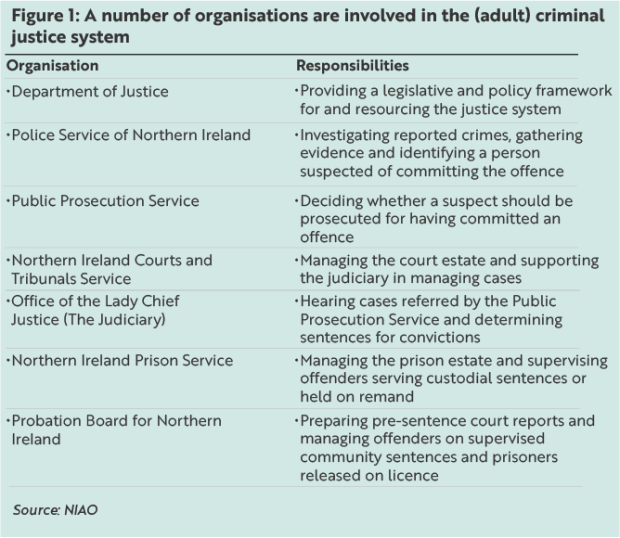
The criminal justice process can deliver a range of outcomes
1.6 The PSNI investigates around 100,000 recorded crimes each year. Two thirds of these will not result in a charge due to evidential problems, or a suspect not being identified. Figure 2 shows how the criminal justice process in Northern Ireland operates.
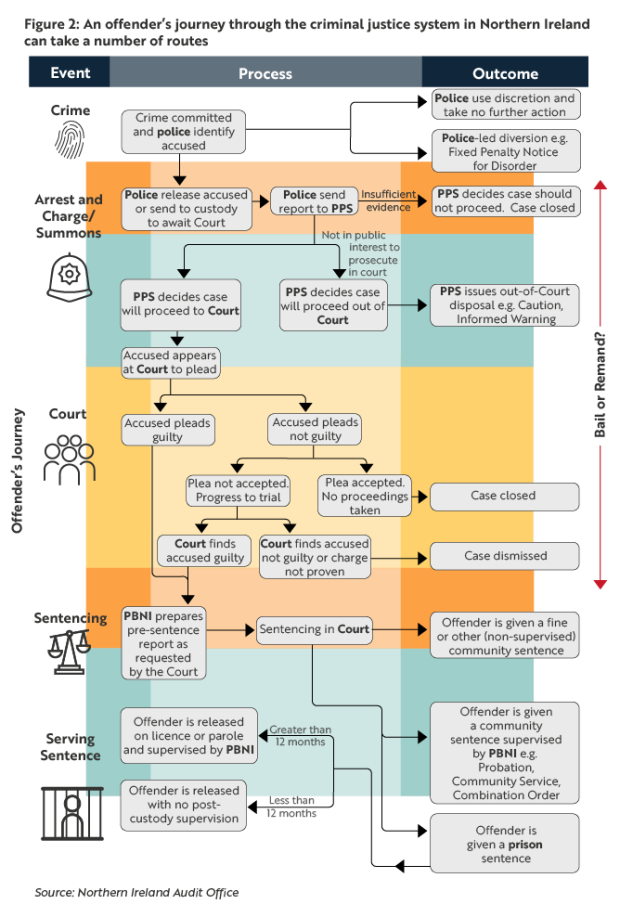
1.7 For cases that do progress following PSNI investigations, various factors determine how these crimes are disposed (Figure 3) including:
- nature and severity of the offence;
- perceived risk to the public;
- impact on the victim; and
- the offender’s personal circumstances, including criminal history and assessed reoffending risk.
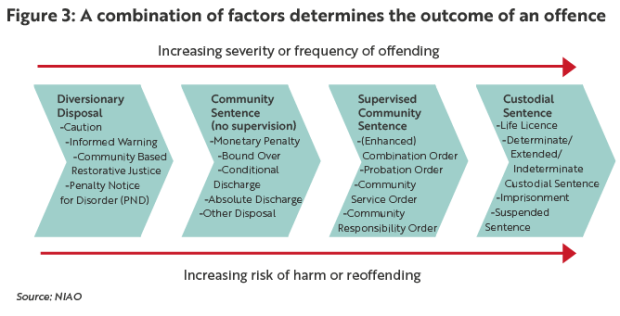
1.8 Where an accused has been identified for a minor offence, both the PSNI and Public Prosecution Service (PPS) can issue a ‘diversionary disposal’. More serious offences, for which the PPS determines there is sufficient evidence and prosecution is in the public interest, are tried in court. The local criminal justice system handles around 35,000 disposals of varying types annually, around 80 per cent of which are disposed at court.
1.9 The impact of COVID-19 saw court activity reduce during 2020 as sittings were suspended and the justice system’s capacity was seriously disrupted. Conversely, out-of-court disposals rose significantly due to new COVID-19 offences being dealt with through Penalty Notices for Disorder (PNDs). In 2021, court activity returned to pre-pandemic levels.
1.10 Following a court conviction, offenders may serve a custodial sentence in a NIPS prison, a community-based sentence supervised by PBNI, or a combination of both. These organisations deliver services and support to offenders to try and prevent reoffending. On average, approximately 3,000 custodial sentences (not including those suspended) are imposed annually (around 13 per cent of total court convictions), with a similar number of supervised community sentences imposed. However, roughly 14,000 convicted offenders each year (around 60 per cent) receive a community-based disposal without supervision, primarily a fine. Figure 4 provides a typical breakdown of the outcomes of recorded crimes.
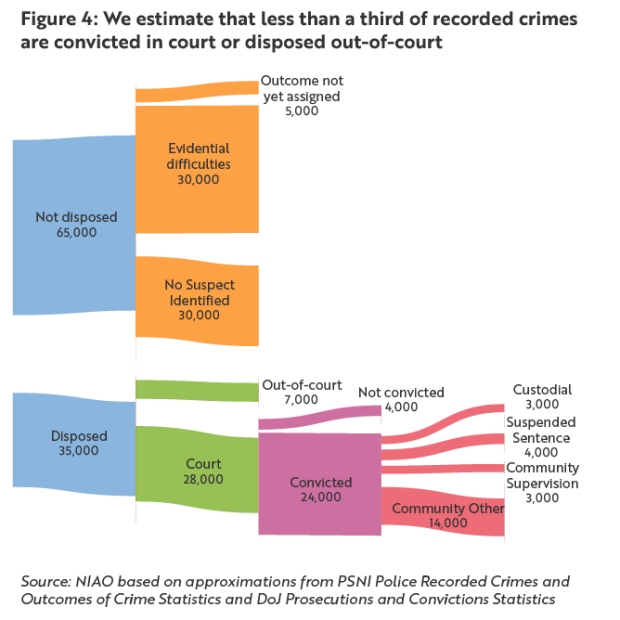
The number of offenders and reoffenders has reduced notably but the reoffending rate has not shown comparable improvement
1.11 PfG Outcome 7 is underpinned by a specific Key Indicator 39 which aspires to a reduction in the reoffending rate, although a target for the level of reduction in the reoffending rate has not been set. We discuss this issue further in Part Five. Effectiveness in delivering Outcome 7 is mainly measured through the ‘one-year proven reoffending’ methodology, which tracks offending behaviour for twelve months after someone has been through the criminal justice system.
1.12 Between 2013-14 and 2019-20, the total number of adults who received a non-custodial court disposal, a diversionary disposal or who were released from custody each year fell by 23 per cent from 25,164 to 19,344 and those who reoffended fell by 29 per cent from 4,353 to 3,098 (Figure 5), resulting in a reduction in the reoffending rate from 17.3 per cent to 16.0 per cent over this period. Despite this positive outcome, the latest statistics for 2019-20 reflect the impact of the pandemic on individuals’ freedoms and behaviour, alongside disruption to the courts system (paragraph 1.9) and, consequently, the number of reconvictions recorded. Prior to this, the reoffending rate had shown a slight increase since 2013-14 (to 17.9 per cent in 2018-19).
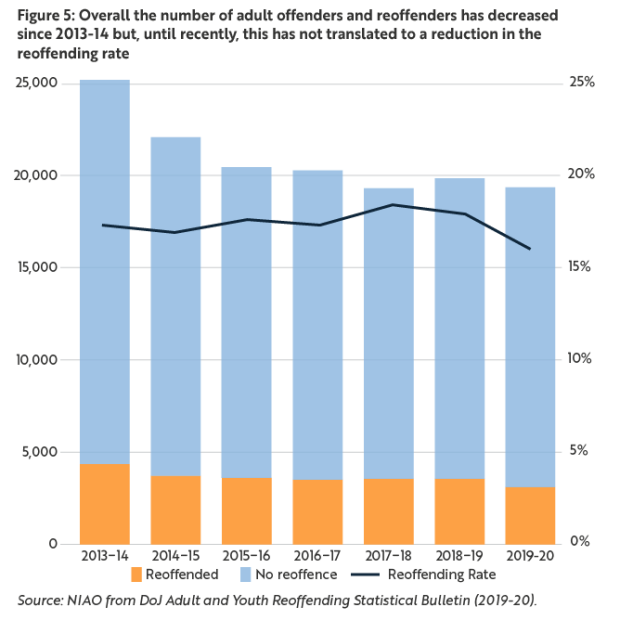
Multiple ‘criminogenic needs’ influence reoffending behaviour
1.13 Various individual or social risk factors, or ‘criminogenic needs’, are associated with reoffending risk, and can be categorised as either `static’ or `dynamic’. Static factors include criminal history, age and gender and can be routinely analysed for trends (Figure 6). However dynamic factors, such as accommodation, employment, relationships and drug misuse, are amenable to change, and measuring their impact is difficult due to their complex interrelationships. Reoffending is typically influenced by a combination of these factors. Policy makers must therefore understand such influences to target interventions at the highest risk groups.
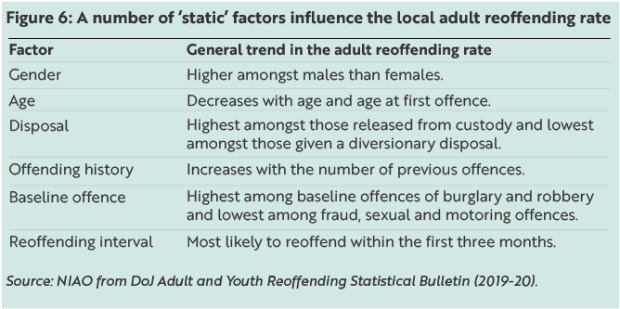
Offending and reoffending rates are highest amongst young males
1.14 Locally, males account for over 80 per cent of court prosecutions and 96 per cent of the average daily prison population. Likewise, males dominate the overall offending cohort (80 per cent) and exhibit higher reoffending rates; approximately 19 per cent of adult males reoffend annually compared to around 12 per cent of females.
1.15 Younger adults are also a high-risk group. While adults aged under 40 comprise around a quarter of the local population, they represent over two thirds of both court prosecutions and the prison population. Reoffending is highest for those aged 18-19 (around 21 per cent in 2019-20) but progressively reduces to around 5 per cent for those aged 60 and above (Figure 7). Similarly, reoffending is highest amongst those who initially offend at a young age.
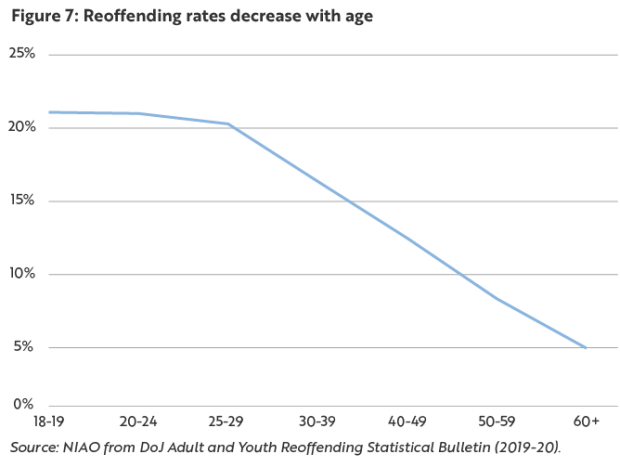
Criminal history and the nature of the baseline offence strongly influence reoffending patterns
1.16 Persistent or ‘prolific’ offending is a key problem in NI. The latest reoffending statistics (2019-20) show that two thirds of the adult cohort had a criminal history, with more than a quarter having committed over ten previous offences. Of those who then went on to reoffend within the twelve-month observation period (3,098 adults), two thirds committed multiple reoffences, ranging from two to 32 crimes. In total, over 10,000 proven reoffences were recorded i.e. more than three per reoffender. The Department told us that this ‘hard-to-reach’ group of prolific offenders is inhibiting further or faster reductions in the overall reoffending rate (paragraph 1.12).
1.17 Those who commit acquisitive crimes such as burglary, robbery or theft are also most likely to reoffend, whilst individuals committing fraud, motoring or sexual offences exhibit low reoffending rates (Figure 8).
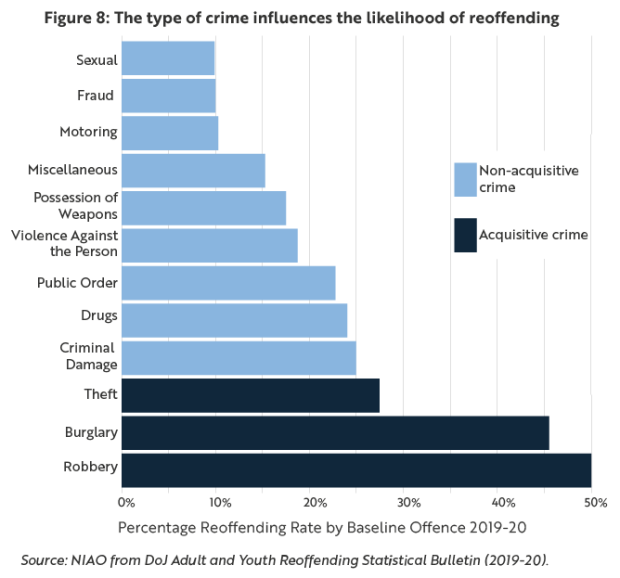
Reoffending is highest among those released from custody, and is most likely to occur within the first three months after discharge
1.18 Evidence also shows that those serving custodial sentences have the highest reoffending rates. For 2019-20, the respective one-year adult reoffending rates were:
- released from custody - 46 per cent;
- non-custodial disposal with community supervision - 29 per cent;
- non-custodial disposal without supervision - 15 per cent; and
- diversionary disposal - 12 per cent.
1.19 Almost half of reoffenders do so within the first three months of being discharged from custody, receipt of non-custodial disposal or diversionary disposal. Approximately one fifth will do so within the first month.
Offenders have a higher prevalence of dynamic risk factors associated with reoffending
1.20 Dynamic criminogenic needs (Figure 9) also contribute towards people initially committing crimes and contact with the criminal justice system can exacerbate these, bringing repeated offending. Ministry of Justice (MoJ) studies indicate that those with a higher prevalence of need have the greatest reoffending risk, and that levels of need amongst offenders vary with static factors such as gender, age and sentence type. In addition, some factors are particularly associated with certain types of crime, for example, drug misuse is closely linked with acquisitive crimes such as shoplifting, and alcohol misuse with violence. Learning disability, mental health issues and low psychosocial maturity can also affect how offenders respond to support for their criminogenic needs.
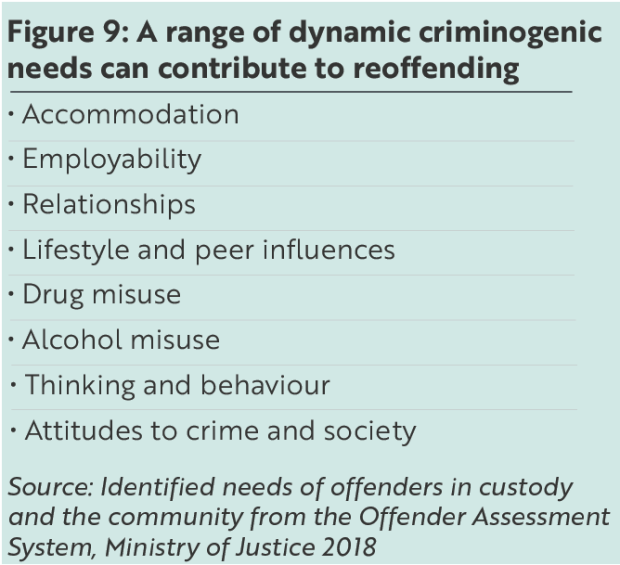
1.21 Dynamic risk factors are reflected within the profile of the local custodial population, as indicated by an analysis of Prisoner Needs Profiles created in 2022:
- 74 per cent left school at age 16 or under and 32 per cent had no qualifications;
- 67 per cent were receiving social security benefits;
- 66 per cent reported having used drugs at some stage in their life;
- 53 per cent had children;
- 33 per cent had some form of contact with mental health services prior to custody;
- 30 per cent had experienced low mood or depression;
- 21 per cent considered themselves to have learning difficulties or disabilities; and
- 12 per cent were homeless or were living in a hostel prior to custody.
1.22 Paragraphs 1.14 to 1.21 outline how reoffending is very high amongst specific groups, together with key factors which influence reoffending behaviour. If local reoffending levels are to be further reduced, the key statutory stakeholders must take full consideration of the wealth of information available, and target strategies and interventions towards these groups.
Scope and Structure
1.23 Our report considers how effectively DoJ has worked with the key justice organisations to reduce adult reoffending. Younger offenders have been excluded from the scope of the review as they were covered separately in our 2017 report.
1.24 We examined both custodial and community settings to determine how different parts of the justice system work individually and collectively to develop, implement and assess initiatives aimed at diverting offenders from crime.
1.25 Many societal problems that trigger offending (paragraph 1.20) are not within the remit of the justice system. These include accessibility of health services, poverty levels, social deprivation and unemployment, a lack of affordable and suitable housing and low educational attainment. As such, primary prevention of offending best sits outside the justice system, delivered through good quality universal services, with targeted additional support for high-risk individuals and groups, supported by commitment from the health and education sectors and other partners. Our report only considers, however, how the justice system seeks to address these wider factors in managing offenders within their remit.
1.26 The report examines:
- the Department’s approach to reducing reoffending (Part 2);
- the key strategic challenges faced (Part 3);
- the services provided to help the rehabilitation of offenders (Part 4); and
- assessing performance and measuring outcomes (Part 5).
1.27 Our review used a range of investigative and research methods (Appendix 1).
Part Two: The Department’s approach to reducing reoffending
The Department’s approach to reducing reoffending
Reducing reoffending has been a longstanding objective of the justice system, with an evolving approach focused on desistance and rehabilitation, but a more clearly defined strategic direction could have produced better results
2.1 A key objective of the justice system is to rehabilitate offenders so that they do not reoffend having completed their sentence. Stakeholders widely acknowledge that achieving lasting reductions in reoffending requires significant investment and joint working across the justice system, alongside other government and voluntary sector bodies. However, achieving this objective is challenging, requiring the justice sector to clearly identify the change it can effect, and where it requires broader input. The extent to which DoJ has clearly defined, monitored, and economically quantified this is unclear, with its approach having evolved in response to various related developments across the justice system and wider government since 2011 (Figure 10).
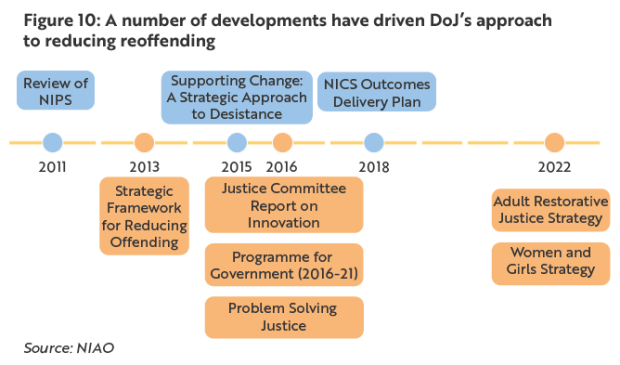
A Strategic Framework and Desistance Strategy have predominantly guided the Department’s work in this area, but their overall effectiveness has not been determined
2.2 Two key documents have guided DoJ’s strategic direction for reducing reoffending over the past decade: a 2013 Strategic Framework for Reducing Offending and a 2015 Desistance Strategy (Figure 11). In line with considerable evidence supporting the approach, both promoted the concept that punitive measures alone would not sustainably reduce reoffending, and that a focus on enabling offenders to reform and desist from crime was also needed.
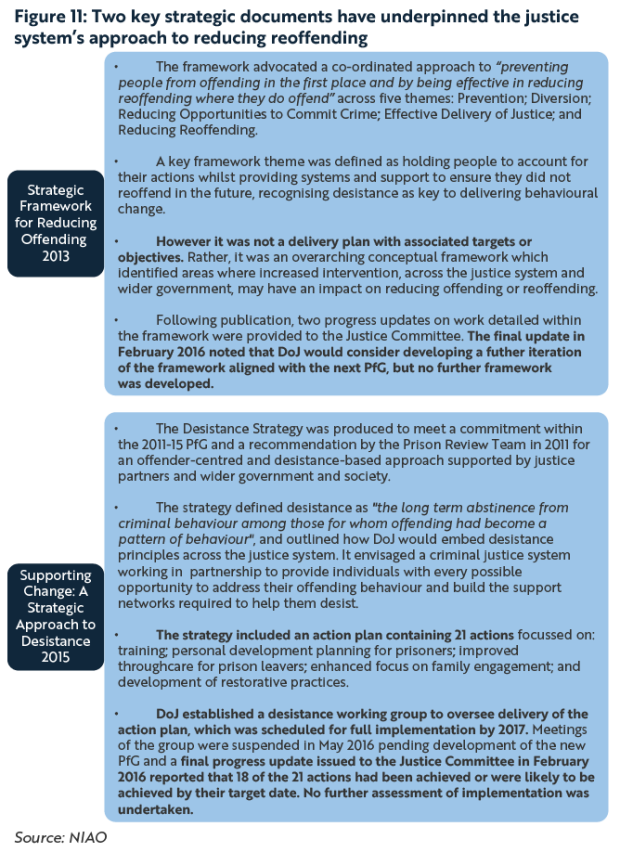
2.3 Although both documents cited reduced reoffending as an objective, in our view, neither represented an overarching strategy or measurable strategic plan for delivering this. Whilst the Strategic Framework was a significant piece of work, which envisaged outcomes such as a reduction in reoffending and fewer first-time offenders, it did not include a delivery plan with associated targets or objectives to achieve these. Rather, it represented a conceptual narrative aimed at promoting joined-up working and highlighting wider governmental action that should contribute to tackling the underlying causes of offending behaviour. Positively, the Desistance Strategy, which was solely justice-focussed setting out how DoJ would deliver change through applying desistance principles across the system, did contain a detailed action plan, however it did not include arrangements for evaluating its impact.
2.4 Progress reporting indicated that implementation of the desistance action plan had some success, with the final update (February 2016) reporting that 18 of the 21 actions had been achieved or were likely to be achieved by their target date. Part Four examines the outworking of some of these actions, including introducing personal development planning for prisoners. However, evidence underpinning the progress reported for some other key actions is limited. For example, developing an engagement plan for work with other departments was reported as ‘likely to be achieved by target date’ of March 2016 but we saw no evidence that such a plan was produced. Likewise, work to improve data relating to the effectiveness of reducing offending interventions was assessed as ‘complete’, based on an initial analysis of one VCS employability programme. This work did not develop any overall means of data capture or analysis, nor identify suitable measures or indicators to support DoJ in measuring progress, as per the initial intention. The wider issues of outcomes and performance measurement are further examined at Part Five.
2.5 Monitoring of both the Framework and Desistance Strategy ceased in 2016. Their final implementation was not formally appraised and, consequently, it is unclear whether their objectives were fully achieved, prior to DoJ embarking on new work under the subsequent PfG.
Although the 2016-21 draft Programme for Government increased the focus on reducing reoffending, DoJ did not establish a strategy to support it
2.6 The 2016-21 (draft) PfG framework, and subsequent NICS Outcomes Delivery Plans (ODP), established reducing reoffending as a key focus area across government within Outcome 7 (paragraph 1.3), led by DoJ, with progress to be measured mainly via a reduction in the reoffending rate (Indicator 39). To provide strategic direction, oversight and monitoring of progress towards this objective, DoJ established a Reducing Reoffending Strategic Outcomes Group (RRSOG) in May 2017, with membership comprising senior DoJ, NIPS, PBNI, YJA, and PSNI officials.
2.7 Although facilitating partnership working across several key justice sector partners, the membership decided in April 2018 that a formal strategy for reducing reoffending was not required. A commitment to develop a short strategic narrative was also later deferred in June 2019 in the absence of a functioning Executive. Instead, DoJ has relied upon the NICS ODPs, and strategic priorities noted within Corporate and Business Plans, to drive work in this area. These, however, do not specifically set out how the justice system has prioritised areas for focus and investment in reducing reoffending, or what the various statutory stakeholders or initiatives are expected to contribute to achieve this objective.
2.8 The Department has confirmed that the overarching approach within the 2013 Strategic Framework (paragraphs 2.2 to 2.3) remains fit for purpose. However, in our view, it is unclear how a framework setting out the criminal justice landscape a decade ago, and its interplay with wider governmental and societal initiatives at that time, remains current today. For example, it does not take account of more recent significant developments discussed later in this report, such as rising levels of short-term and remand prisoners, and an increasing prevalence of mental health issues.
2.9 As a result, we consider that there has been insufficiently robust strategic direction for developing, monitoring and prioritising collaborative work to reduce reoffending, particularly in recent years. Consequently, there remains inadequate evidence of what works well locally, and the justice system is poorly sighted on outcomes or value for money achieved from its investment in this area. Such information is required to inform the development of a formal reoffending strategy or plan, which clearly outlines the work required to deliver measurable outcomes and benefits.
2.10 In England and Wales, by comparison, Her Majesty’s Prison and Probation Service (HMPPS) published Regional Reducing Reoffending Plans in 2021, setting out the most important activities each region is prioritising to reduce reoffending between 2022-25. These plans are supported by specific targets and objectives, across four areas:
- training skills and work;
- drugs and alcohol addiction;
- family, accommodation and readjustment to society; and
- public security through engagement and compliance.
More recently, DoJ has focussed on several discrete strategic areas, which may help reduce reoffending, but funding constraints threaten their implementation
2.11 In recent years, DoJ has focussed on a number of discrete strategic areas, which it expects will further advance rehabilitation efforts and consequently reduce reoffending, however, in the absence of an overall reoffending strategy (paragraphs 2.7 to 2.9), their anticipated contribution to the objective is unclear.
2.12 Firstly, within the June 2018 and December 2019 ODPs (paragraph 2.8), DoJ committed to introduce `Problem Solving Justice’ (PSJ) initiatives, reflecting recommendations from a 2016 Committee for Justice report, which called for more innovative ways of addressing the root causes of offending. Between 2019-20 and 2022-23, DoJ has prioritised around £8.2 million of budget to allocate to partners across justice and wider government, to develop, pilot and evaluate a portfolio of PSJ projects within a five-year plan. Whilst some projects, such as Multi-Agency Support Hubs, aim to support vulnerable people through early intervention and prevention, others place offenders in tailored programmes under court supervision, including:
- Enhanced Combination Orders (ECOs), which provide judges with a more intensive community sentence option, instead of a short-term prison sentence;
- Substance Misuse Courts (SMCs), which place offenders on intensive treatment programmes, with final sentencing taking account of participation; and
- Mental Health Courts (MHCs), which aim to ensure that offenders with mental health issues can access treatment while being subject to proceedings.
2.13 Progress in implementing these specific projects is assessed in greater detail in Parts Three and Four. The five-year plan set out an implementation schedule and multi-year evaluation programme for each initiative, including a review of the wider PSJ Programme in 2022-23 and an overall Economic Impact Assessment in 2024-25.
2.14 Delivery of individual PSJ initiatives is subject to affordability and business case approval. However, given the considerable financial pressures and reducing budgets that the Department currently faces, further advancement of the PSJ programme has been significantly impacted, with its component initiatives at various stages of development and evaluation. DoJ estimates that further expansion of PSJ will cost an additional £6.3 million by 2024-25, meaning it is unclear whether any further progress will be achieved. An overall review of the programme is now required to inform the future strategic direction and priority of this work.
2.15 In addition, two further DoJ strategies, launched in March 2022, aim to supplement current approaches to rehabilitation:
- A Restorative Justice Strategy aims to increase the use of restorative practice within the adult justice system and across all types of disposals. This followed recent developments within youth justice and recommendations within various reports which advocated its use. The strategy envisages that adding restorative practice to current rehabilitation work will help contribute to reduced reoffending, whilst also addressing victims’ needs.
- Although females account for around a fifth of offenders (paragraph 1.14), their contact with the justice system can have a profound and lasting impact on them and their families. A Strategy for Women and Girls was therefore developed, aimed at introducing gender-responsive prevention and early intervention approaches to tackle underlying issues and provide tailored support in, and beyond, custody.
2.16 Stakeholders view both initiatives as having potential to deliver real change, albeit somewhat overdue. However, significant financial constraints mean resourcing to implement the associated action plans has not yet been identified. Delivery is again subject to individual affordability or identification of innovative funding sources, and considerable uncertainty therefore also exists over whether these strategies will proceed as envisaged.
Alongside better strategic planning for reducing reoffending, accountability structures for monitoring performance require improvement
2.17 Although RRSOG initially reported progress against Outcome 7 of the ODP to The Executive Office (TEO), formal progress monitoring by TEO ceased following the revised ODP published in December 2019, as work had commenced to develop a new PfG which would, in theory, supersede it. Although consulted upon in 2021, a new PfG was not established prior to the subsequent collapse of the Executive in February 2022. No alternative mechanism was established for reporting on reducing reoffending by RRSOG.
2.18 The RRSOG has had no role in overseeing the more recent PSJ range of initiatives (paragraphs 2.12 to 2.14), which might potentially deliver tangible reoffending benefits. Furthermore, its membership has not included wider justice partners such as the judiciary, NICTS or PPS, whose involvement might have offered broader insight and perspective on issues impacting on reoffending, for example sentencing policy and practice. The Criminal Justice Board (CJB), comprising such representatives, has oversight of criminal justice in NI and could potentially provide valuable input to the RRSOG’s work, but no formal relationship between the two groups has been established.
2.19 DoJ told us that it is currently evaluating RRSOG’s terms of reference to help identify its future oversight priorities. It is important that this review also considers how the strategic direction (paragraphs 2.7 to 2.9) and accountability arrangements for reducing reoffending can be enhanced, including defining:
- DoJ’s priority work areas and their expected contribution to an overall reduction in the reoffending rate, including how this will be measured;
- the anticipated costs and benefits of achieving improvement;
- areas where improved cross-governmental collaboration is required to deliver better rehabilitation and reoffending outcomes; and
- a clear reporting structure for the group, such as potentially establishing formal links to the CJB and PSJ delivery teams, and for regular progress and performance reporting to DoJ.
Recommendation 1
The Department should carry out a review of its 2013 and 2015 strategic initiatives to ascertain how successful they have been in achieving outcomes. This learning should then be used by the Department to better define its strategic plan for reducing reoffending across key desistance pathways such as accommodation, employability and health, taking account of how cross-governmental collaboration can be strengthened to support justice aims in the short-term. It should also strengthen oversight and reporting arrangements to ensure successful delivery of these aims, including establishing formal links with the Criminal Justice Board (CJB). Finally, in the medium-term, and to align with any new Programme for Government agenda when published, the Department should take the lead in developing a cross-governmental strategy and action plan for reducing offending and reoffending.
Insufficient clarity on the economic and social costs of reoffending in NI, alongside public expenditure allocated to address it, further limits DoJ’s ability to plan and evaluate its work
2.20 A conservative estimate of the total annual economic and social cost of reoffending in England and Wales is £18.1 billion, £16.7 billion of which relates to adult reoffenders. This spans three broad categories of costs identified by the Ministry of Justice (MoJ):
- Costs in anticipation of crime (£2.6 billion): costs incurred by individuals and businesses to protect them from crime e.g. crime detection and prevention, defensive equipment, insurance;
- Costs as a consequence of a crime (£10 billion): direct costs to individuals and services arising from crime, including: human and emotional costs (such as physical or psychological injury); value of property stolen; lost output at work; and NHS and victim services costs; and
- Costs in response to crime (£4.1 billion): costs associated with police investigations, court processes, and prison detention.
2.21 By comparison, very little information is available on reoffending costs in NI, either incurred directly by the justice system or in terms of how wider society is impacted. However, based on the MoJ estimates, these costs are likely to be substantial, highlighting why government needs to support effective reducing reoffending initiatives.
2.22 Limited information is also available on expenditure targeted at reducing reoffending. For example, DoJ cannot identify how much, overall, criminal justice organisations spend in delivering the PfG / ODP commitments, or its total resource costs incurred on policy and strategy development and implementation. It told us that there is no defined budget for this work, with resources derived through separate policy areas and as part of specific programme budgets. The various strategies and initiatives which contribute to, but are not always necessarily directly aimed at, improved reoffending outcomes make it difficult to accurately attribute expenditure to this area.
2.23 DoJ further explained that disaggregating indirect expenditure would present significant challenges not only for it, but for the NICS generally and, if possible, the potential to analyse its specific impact would be inhibited by causality, given that many of the factors affecting reoffending such as accommodation, employment and healthcare are outside the Department’s control. DoJ believes that doing so is therefore not practical nor possible and, as a result, we could not identify a wholly reliable estimate of how much the local justice system spends on trying to reduce reoffending and support offender rehabilitation.
2.24 NIPS and PBNI, however, provided financial information which identified their direct budget allocation, i.e. funding directed specifically to activities that support rehabilitating and resettling offenders in their care, at around £16.1 million in 2022-23 (Appendix 2). Whilst incomplete information on the economic and social impact of reoffending for NI society (paragraph 2.21) makes it difficult to assess the adequacy of funding directed towards addressing the issue, £16.1 million may represent relatively modest support. Assessing costs and benefits facilitates evidence-based decisions that enable limited resources to be targeted cost-effectively. However, to properly evaluate this in overall terms, and at individual programme level, the key statutory bodies require better information on total costs arising from local reoffending.
Recommendation 2
The Department should devise an approach for estimating the economic and social cost of reoffending in Northern Ireland, drawing upon approaches used in other jurisdictions. It should then use this information to assess the adequacy of expenditure directed towards trying to reduce reoffending, and to help inform policy, strategy and potential invest-to-save initiatives going forward.
“Very little information is available on reoffending costs in NI, either incurred directly by the justice system or in terms of how wider society is impacted. However, based on the MoJ estimates, these costs are likely to be substantial, highlighting why government needs to support effective reducing reoffending initiatives.” – Northern Ireland Audit Office
Part Three: The key strategic challenges
The key strategic challenges
A significant proportion of prisoners have limited access to rehabilitation services
3.1 A range of rehabilitation services are provided within custodial and community settings for those who have offended. We outline and evaluate these in Part Four. However, a significant proportion of the prison population have limited access to such rehabilitation initiatives, namely short-term prisoners and those being held on remand, and evidence suggests that this has a significant impact on the potential for reoffending.
Northern Ireland has the lowest UK prison population but a comparatively high proportion of short-term prisoners who receive little rehabilitation
3.2 Determining an appropriate sentence for a convicted offender is the responsibility of the independent judiciary. In NI, legislation sets maximum, and sometimes minimum, penalties for offences, but judges still have considerable discretion over sentencing, meaning they have to carefully consider the circumstances of each case to determine a suitable response.
3.3 For serious offences, prison is often necessary to provide punishment and protect the public, but evidence suggests that prison itself can be criminogenic, given that its environment, culture and regime can increase the likelihood of an offender’s further involvement in criminal behaviour. Alongside potentially damaging effects of imprisonment on personal lives, such as weakening social ties, creating stigma, and losing employment or housing, there are clearly potential questions over its general effectiveness. However, in overall terms, NI has the lowest prison population in the UK, with 96 prisoners per 100,000 population in 2020-21, comparing favourably with 173 in England and Wales and 162 in Scotland.
3.4 Despite this, a much greater proportion of local adult prisoners are serving short-term sentences (less than one year). These significantly disrupt the lives of offenders and their families but offer little rehabilitative support because of the limited time available to do so. Such offenders therefore often leave prison in poorer circumstances than when entering, and are impacted far beyond the punishment intended by the court for the severity of the crime committed. Over three quarters of sentenced offenders committed into custody in NI during 2021-22 (513 individuals) received a short custodial sentence, and those prisoners constituted just over one quarter of the daily average sentenced prison population over the year. Available information suggests the rest of the UK has a much lower ratio of short sentence prisoners (Figure 12).
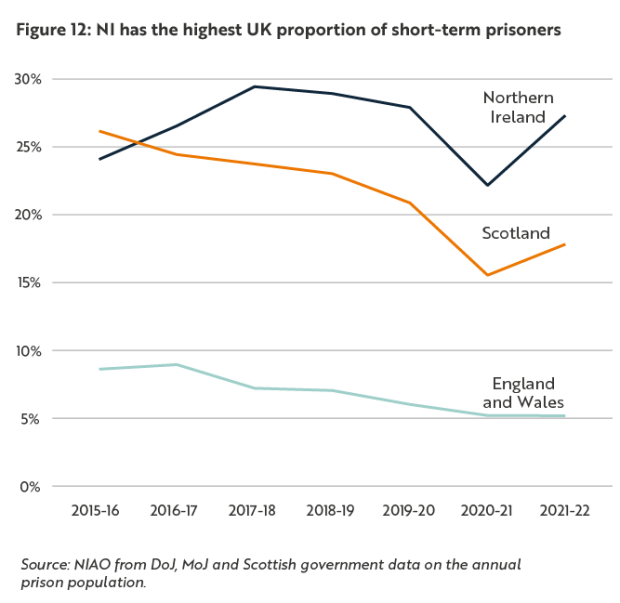
Short-term prisoners are a significant challenge for NIPS and are more likely to reoffend than offenders given less costly community disposals
3.5 Short-term prisoners present significant challenges to NIPS, particularly given the administrative and financial impact of a high turnover of individuals within its prisons. Many have numerous previous convictions and higher criminogenic needs but, in NI, those serving sentences of under one year spend an average of four months in prison, indicating the scarce time NIPS has to prepare prisoner plans and commence any form of meaningful rehabilitative work. CJI highlighted clear challenges around this issue in 2018.
3.6 Prioritisation of resources towards longer sentence prisoners, who must demonstrate reduced reoffending risk before release, means short-term prisoners are also often low down rehabilitation waiting lists. More recently, increased backlogs and waiting lists arising from Covid mean short-term prisoners are increasingly unlikely to receive support. However, NIPS cannot quantify the extent of this problem.
3.7 As a result, short-term prison sentences are linked to high rates of reoffending. MoJ reports in 2015 and 2019 found that prison sentences of under twelve months correlated with higher proven reoffending rates (by 4 percentage points) than community orders and suspended sentences, and local reoffending data highlights similar trends. In 2019-20, 46 per cent of adult custody releases in NI reoffended, compared with 29 per cent for supervised community orders (paragraph 1.18). More significantly, longstanding patterns show highest reoffending rates amongst prisoners serving the shortest sentences. Each year, around half of those released following a sentence of under 12 months reoffend, increasing to 57 per cent (2019-20) for those serving under 3 months. In contrast, around 12 per cent of those serving over three years reoffend (Figure 13).
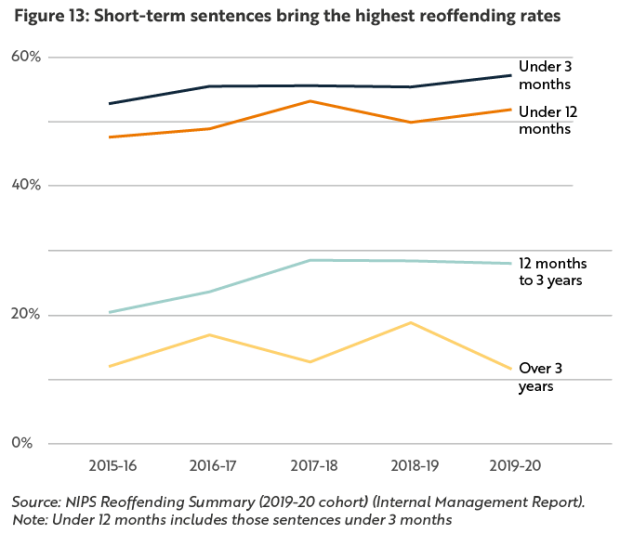
3.8 Although the risk profile of an offender may be linked with their likelihood of reoffending, the weight of evidence suggests that non-custodial disposals are generally more effective in rehabilitating offenders and reducing reoffending than prison sentences, particularly when compared with short-term sentences. Community orders can, in appropriate circumstances, penalise offenders without extensively disrupting lives. For example, they can restrict offenders’ liberty whilst serving their sentence under supervision, offer greater access to rehabilitation services, and often ensure engagement in reparative activities. Community orders are also significantly less expensive, as indicated by NIPS’ estimated cost per prisoner place of £44,868, compared with PBNI’s estimated annual cost per supervised community order of between £1,700 and £13,900.
Effective long-term solutions for rehabilitating and resettling short-term prisoners have not yet been implemented
3.9 CJI reports since 2011 have indicated that personal development or resettlement and release planning for local short-term prisoners has been inconsistent or too reactive in nature. Recognising the need for additional support, in June 2016, NIPS introduced the Positive Outcomes for Short-Term Prisoners (POST) project in conjunction with NIACRO (an organisation which supports offenders). POST aimed to encourage participation in purposeful activity and offered support across housing, literacy, employability and skills, alongside sign-posting to key services, with CJI commenting that such a programme was “long-overdue”. Prior to POST, the Prisoner Development Model for rehabilitating custodial offenders did not extend to short-term prisoners.
3.10 However, a 2019 independent evaluation of POST found that service provision was lacking in many aspects: the service was not being offered to all short-term prisoners; required assessments and reviews were not all being held; the lead time to complete baseline assessments was too long; and there was overlap with usual NIPS processes. In addition, limitations in the data available meant that the evaluation could not conclude on whether POST was effective in achieving its aims but noted that it did not appear that it was encouraging desistance. NIACRO told us it has some concerns around the evaluation’s Terms of Reference and methodology and, for this reason, it did not fully concur with the findings.
3.11 CJI recommended in 2018 that NIPS reviews its approach and appropriately targets resources towards short-term, high risk individuals to try and reduce reoffending, also highlighting a need for tailored interventions, streamlined referral and assessment processes and prioritisation of prolific offenders. The Prisons 2020 strategy, published in June 2018, also included an objective to ‘Enhance rehabilitation and resettlement opportunities for people in our prison community through improved Through the Gate provision and developing new approaches to dealing with short-term, high risk prisoners.’
3.12 Although CJI stated that NIPS should deliver actions within one year of its report, work is still ongoing to address service provision gaps, and no definitive action plan was developed to address the specific weaknesses identified by the POST evaluation. NIPS is currently working with PBNI to review their joint service provision for the 2023-24 year, however, whilst intentions were that this review would seek to enhance support for short-term prisoners, this now represents an even greater challenge given the increasing prisoner population, and associated PBNI caseloads, alongside continued COVID-19 recovery.
3.13 To deal with short-term prisoners effectively, stakeholders highlighted the need to make connections between the person and support in the community. This is acutely important considering DoJ statistics which highlight that this group are most likely to reoffend (paragraph 3.7), with approximately half doing so within three months of release (paragraph 1.19), making this the critical period for desistance. Release planning and post-custody support are therefore critical, but are not always adequate, for short-term prisoners.
3.14 A 2016 inspection of resettlement services in England and Wales for short-term prisoners found that their needs were not properly identified and planned for (Figure 14). CJI’s 2018 report confirmed that many of these areas were equally relevant to NI. ‘Exit passports’, which include identification information, GP registration and sustainable accommodation on release, were introduced in 2021-22 following significant delay, having been included in the 2015 Desistance Strategy (paragraphs 2.2 to 2.5). This is a positive development, which has the potential to improve resettlement outcomes for this group in particular, but its impact is not yet clear. The Department told us that the effectiveness of this process has been impacted by the pandemic and subsequent resource pressures.
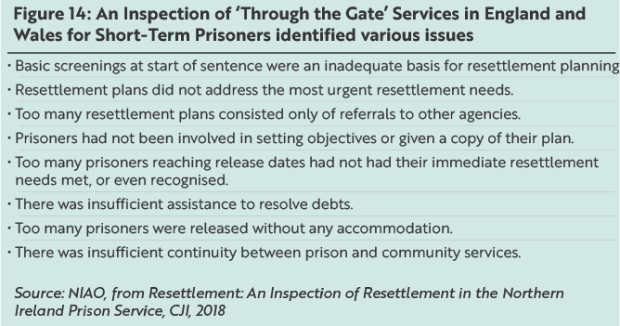
3.15 Longer-term prisoners, by comparison, receive more comprehensive preparation for release, including a detailed release plan and liaison with their prison-based co-ordinator and community-based probation officer to discuss transition. Some must also undertake offending behaviour programmes or pre-release testing where required by Parole Commissioners. Most significantly, longer-term prisoners are subject to periods of statutory supervision on licence by probation officers upon release. However, PBNI has no similar remit for short-term prisoners, despite evidence that they pose the highest reoffending risk. PBNI told us that, currently, probation supervision is tailored specifically to the needs of individuals who pose the highest risk of harm, and that any policy decision to extend its remit would require legislation and significant resources.
3.16 A 2021 NIPS review identified further recommendations to improve rehabilitation outcomes for short-term prisoners (Figure 15), including improving support for community transition. NIPS has appointed two prison governors to take these forward however, at present, systemic and unresolved gaps remain in respect of responsibilities across government to ensure effective transitional and post-custody support.
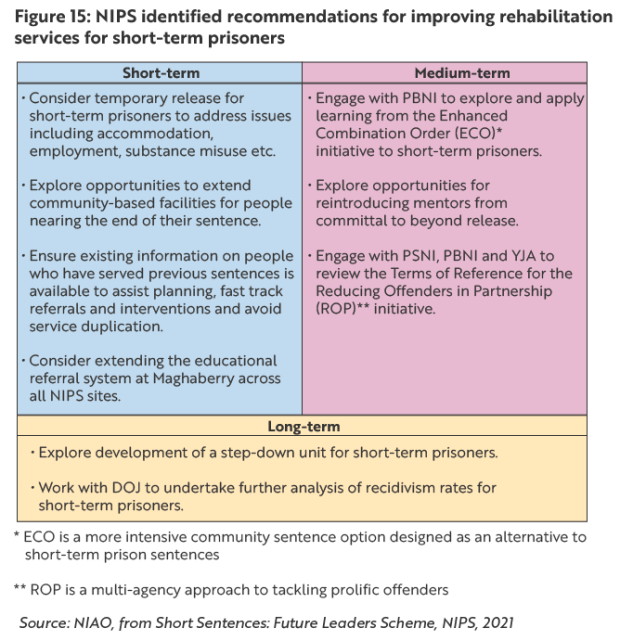
3.17 Continuing support to released offenders through to the community setting (‘through the gate’ support) significantly assists resettlement and reduces reoffending risks. Without any structured community-based support mechanism for short-term prisoners, these individuals, whom research shows often encounter significant problems resettling, have no designated contact point to help them access appropriate services post-release. While the VCS can provide some floating support services, inadequate offender awareness of these, or inability to access them without a statutory referral, limits their impact.
Other jurisdictions have sought to strengthen ‘through the gate’ and post-custody support
3.18 Other jurisdictions are further advanced in developing ‘through the gate’ and post-custody support for short-term prisoners. In 2015, England and Wales extended post-custody licence supervision and rehabilitation support to try and reduce reoffending levels, meaning all released prisoners now receive at least 12 months statutory community supervision. A new resettlement model was then introduced in 2021, which included plans for better continuity of support beyond prison and new specialised short-sentence teams to directly address resettlement needs from point of sentencing to community reintegration. The National Audit Office reported on resettlement services for adult prison leavers in England and Wales in May 2023, concluding that, despite these initiatives, challenges remain in relation to release planning and rehabilitation services for prisoners when they leave custody.
3.19 Scotland also implemented the ‘Throughcare’ scheme across most prisons in 2015, offering a mentoring approach for short-term prisoners, instead of formal post-custody supervision, to enable smooth community transition. This involves support officers working with offenders in prison and following release, to change behaviours and provide practical help with issues including housing, medical provision and benefits. A 2017 independent evaluation found that whilst it was too early to definitively conclude on reoffending rates, Throughcare was impacting positively on service users and the wider prison environment.
3.20 Currently, NI clearly lags behind the rest of the UK in seeking to support community resettlement amongst short-term prisoners. In our view, the major gaps in local support can only be contributing to the inadequate progress in addressing these frequent reoffenders. The criminal justice ‘revolving door’ has clear cost-effectiveness implications. Any investment in these individuals whilst in custody is lost when unresolved or re-emerging issues trigger reoffending, and they return to prison to restart the whole cycle.
Recommendation 3
The Department should develop greater and more timely accessibility to rehabilitation initiatives to address the identified gaps in support for short-term prisoners. It should also review the adequacy of ‘through the gate’ support and, along with all relevant stakeholders, devise a solution(s) to better assist short-term prisoners’ transition to the community and resettlement in the early period post-release.
Enhanced Combination Orders allow judges to pass intensive community sentence options instead of short-term custodial sentences but, despite positive evaluations, they have not yet been rolled out fully
3.21 As paragraph 3.8 indicated, making enhanced use of community sentencing could potentially deliver notable cost savings, alongside improved reoffending outcomes, but providing the right combination of punishment and tailored support in community settings requires an adequate community sentence framework and sufficient capacity among local services to offer a viable alternative to prison. The judiciary in NI told us it is supportive of the principle of community over custody, where appropriate given case circumstances, and where the required community support structures are available to safely address reoffending risks. However, existing community sentencing options do not always provide suitable alternatives for cases close to the custody threshold.
3.22 In 2015, the then Lord Chief Justice asked PBNI to develop and pilot a demanding community order, as an alternative to the high usage of short-term prison sentences, which would be sufficiently challenging to offer adequate punishment while also requiring offenders to address contributory factors to their offending, such as mental health or addictions. Consequently, PBNI began piloting the Enhanced Combination Order (ECO) in the Ards, and Armagh and South Down court areas in October 2015, under the Problem Solving Justice programme (paragraph 2.12). It enables judges to use existing legislation and impose more intense `Combination Order’ community sentences which also aim to address specific offender needs. The initiative was extended to the North-West in October 2018. To date, over 750 people have received ECOs.
3.23 ECOs focus on restorative practice, desistance and victims, with offenders also completing unpaid community work. Mental health issues are assessed by PBNI psychologists, with a treatment plan or referral to appropriate health providers forming part of the intervention. Where necessary, parenting or family support work and accredited behaviour programmes are also included. Non-compliance with an order means offenders are returned to court and potentially sentenced to custody.
3.24 NISRA reviews of the pilot in 2017 and 2019 found it had largely achieved its aims and met participants’ needs. The latter evaluation reported a 20 per cent decrease between 2015 and 2017 in short-term custodial sentences imposed by the courts piloting ECOs and promising participant engagement and completion levels. There was also evidence of reduced reoffending risk. In addition, DoJ reoffending rates for individuals subject to ECOs show an encouraging downward trend from 44.1 per cent in 2016-17 to 27.4 per cent in 2019-20, comparing favourably to the respective rates for short-term prison sentences (paragraph 3.7).
3.25 A March 2019 economic appraisal also identified an expected annual net benefit of £5.7 million to £8.3 million to society if ECOs were fully rolled out across NI. This reflected lower costs of ECOs compared to short-term prison sentences, lower potential reoffending rates and associated costs of crime, the monetary value of unpaid work completed by offenders, and additional revenue from improved employment prospects. Qualitative benefits for offenders’ families and the wider community were also identified. PBNI also highlighted that in the courts using ECOs, short-term prison sentences had reduced by 13 per cent between 2015 and 2019, compared with a 17 per cent increase in non-ECO courts. Figure 16 describes the experiences of one ECO participant.
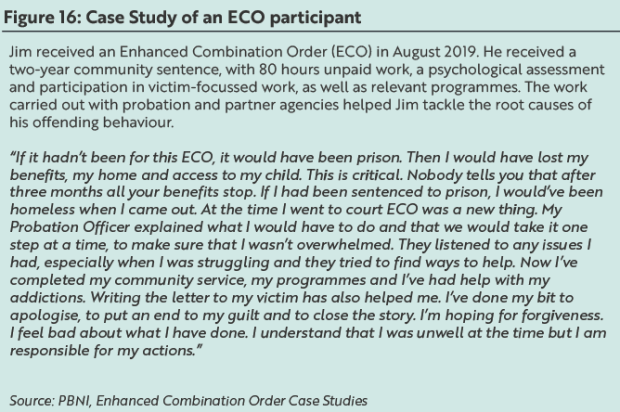
3.26 Given the positive evaluations of ECOs, roll-out across the remaining court areas in NI appears merited, although further work is required to address any operational issues highlighted by the various reports. Plans to introduce ECOs in the Belfast court area in 2021 were impacted by the pandemic and have not progressed further, due to the prioritisation of Covid business recovery across justice, and the current budgetary pressures and uncertainties. Whilst PBNI told us that it is considering how it can expand or mainstream elements of the ECO within current budgets, the present situation, however, creates disparity of local service provision and accessibility.
DoJ has been considering other community sentence options within a local sentencing policy review, but progress has been slow and will require legislative change
3.27 For courts to deliver appropriate sentences, they require effective and appropriate sentencing policy. In June 2016, DoJ announced a Sentencing Policy Review, the first such major local review since 2005. As part of this, between October 2019 and February 2020, DoJ undertook public consultation on various aspects of local sentencing policy, including the potential for four new community disposals:
- a conditional discharge sentence with the option to include community sanctions, administered by the PBNI and/or restorative justice bodies;
- a ‘structured deferred sentence’;
- a ‘supervised suspended sentence’; and
- a diversionary type community intervention for minor first time adult offences.
3.28 The Department subsequently published ‘Sentencing Policy Review Consultation: Way Forward’ in April 2021, which included recommendations arising from the consultation. It highlighted strong support for increased use of community disposals as an alternative to short-term prison sentences and advocated their further development, and also indicated that ECOs would be further expanded. However, it concluded that further work was required on the potential new sentencing options before any definite decisions could be made.
3.29 Implementing the recommendations around any new community disposals will also require legislative changes. Since the consultation document was published, DoJ has been completing the legislative programme under the former Assembly mandate, whilst undertaking preparatory work for the new Sentencing Bill, including consideration and costing of the potential new community disposals with PBNI.
3.30 Whilst recognising that the review is a significant and complex piece of work, it is now almost seven years since it was announced, and it is therefore important that this work continues to be progressed with priority. Any advances could potentially bring major benefits for the local justice system, as new community disposals could deliver better outcomes for offenders and reduce court backlogs. DoJ envisages bringing the new legislation forward early in the next Assembly mandate, however the absence of a functioning Assembly could impact the timing of the legislative process.
3.31 In designing any new local policy, DoJ needs to consider the success of measures already operating elsewhere. For example, the rest of the UK has rationalised its approach to community sentencing, introducing a single community order which can be tailored to individual offenders by supplementing it with a range of requirements:
- In Scotland, Community Payback Orders (CPOs) replaced various other sentencing options in 2010. CPOs may entail up to nine requirements, including unpaid work, compensation or supervision, or a requirement to undertake mental health, drug or alcohol treatment. The 70 per cent successful completion rate since 2012 is consistently higher than previous sentencing options.
- Initially introduced in 2005, a Community Order in England and Wales can now include up to 15 requirements, with offenders given a suitable combination based on their offence. Courts must ensure at least one condition is punitive in nature, and that restriction on liberty is commensurate with offence seriousness. Although a recent review noted a decline in their use, the rate of successful completion has increased (from 64 per cent in 2009 to 69 per cent in 2019).
Other jurisdictions have legislated to encourage greater use of community sentences
3.32 Local legislation requires that a court shall not pass a custodial sentence unless the offence(s) was so serious that only a custodial sentence can be justified. However, each year, many cases fall just at the threshold between a short-term custodial and community sentence and, for various reasons, sentences imposed by the courts are not always consistent. Some countries have sought to define more clearly, within their sentencing laws, the circumstances when custody is appropriate, to try and ensure equitable offender treatment and reduce the use of short-term custodial sentences (Figure 17).
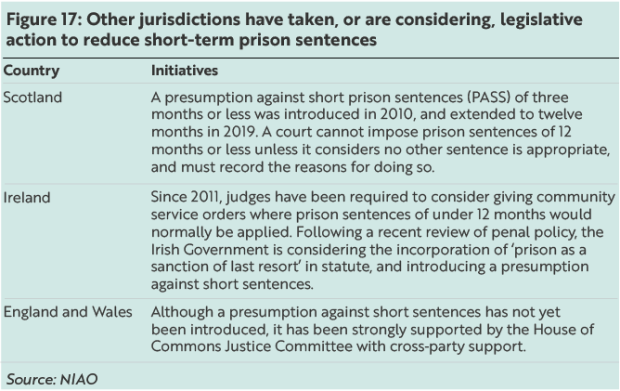
3.33 A statutory presumption against short-term sentences was recommended for NI by the Prison Review Team in 2011. However, this has not yet been implemented, and the recent Sentencing Review consultation (paragraph 3.27 to 3.30) did not seek views on introducing a presumption, noting concerns over potential “up-tariffing” of sentences, and stating that the Department would maintain a watching brief over this area. DoJ should therefore continue to monitor developments across the UK and Ireland, as part of its consideration of the local sentencing policy and legal framework, taking account of the comparatively high proportion of prisoners serving short-term sentences locally.
Recommendation 4
The Department, in conjunction with stakeholders, should complete its review of sentencing with the aim of providing the judiciary with viable community-based alternatives to short-term prison sentences. This work should consider how to fully roll-out the positively evaluated Enhanced Combination Order (ECO) pilot across Northern Ireland, and include plans to legislate for any new community disposals in the next NI Assembly mandate. The Department should also give policy consideration to the legislative options available for strengthening the principle of prison as a sanction of last resort for cases which may result in a short-term prison sentence.
The high level of remand prisoners in NI presents costly administrative problems for NIPS
3.34 The police and judiciary must both decide at various stages of the criminal justice process whether suspects should be remanded in custody or released on bail. Police bail may be granted following arrest, pending investigations and charge decisions, or post-charge whilst awaiting the initial court hearing. The judiciary must also consider bail applications by defendants at the arraignment and trial stages of cases, and refusal to grant bail at these points mean suspects will spend time in a NIPS prison.
3.35 Custody remands account for over three quarters of all prisoners received by NIPS. Similar to short-term prisoners, the proportion of local remand prisoners is considerably higher than other UK jurisdictions and has risen sharply since 2015-16 (Figure 18). On average, remand prisoners comprised 37 per cent of the NI prison population in 2021-22, compared with 25 per cent in 2015-16, and over double the proportion in England and Wales (17 per cent). While this increase partly reflects pandemic case backlogs, trends had already been rising before this.
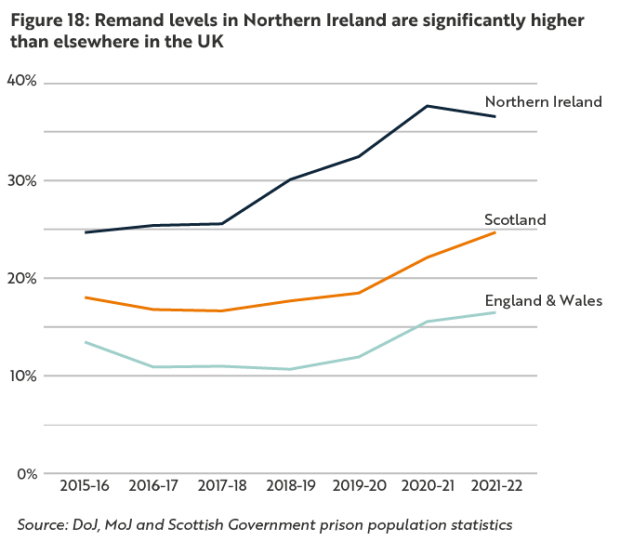
3.36 Untried prisoners comprise around two thirds of remand cases in England and Wales and over three quarters in Scotland, but NIPS systems cannot identify the different types of remand prisoners held in custody in NI. However, around 47 per cent of local prisoners committed to remand in 2020 (over 1,300 people) did not ultimately receive a prison sentence, indicating how many remands may be avoidable.
3.37 People are also increasingly spending longer periods on remand in NI. Twenty-one per cent of those who were committed into custody in 2020 spent over three months on remand, with 98 individuals spending over one year on remand. This compares with 15 per cent, and 54 individuals, in 2017, primarily reflecting increasing case processing times by courts. In 2018, we reported on the failure of the local criminal justice system to complete cases within reasonable timescales. Recent DoJ statistics show that the position has deteriorated further, with the average completion time for cases at all courts having increased by 40 per cent, from 162 days in 2017-18 to 226 days in 2021-22.
3.38 Whilst there has been no analysis of the respective costs of remand and bail, it is generally accepted that bail costs would be significantly less than the costs of prison detention (£44,868 cost per prisoner place in 2021-22). In addition, DoJ told us that whilst the prison estate was funded to house 1,450 individuals, there were over 1,850 in its custody at mid-April 2023. Reducing remand levels would therefore also help NIPS to better manage its custodial responsibilities within its current resources.
NIPS has limited scope to support remand prisoners and, consequently, reduce their reoffending risk
3.39 Reoffending rates for prisoners who spent time on remand are not specifically analysed by DoJ, however stakeholders consider that high remand levels influence reoffending in two ways. Firstly, the significant processing and throughput demands placed on NIPS reduces the resources available to focus on rehabilitating convicted offenders. Secondly, NIPS again has limited scope to work with remand prisoners as, in many instances, they have not yet been convicted of a crime.
3.40 Remand prisoners tend to be focused on their case defence, rather than future resettlement prospects. In 2020, one fifth of these prisoners ‘refused to engage’ with their committal interview, with almost two fifths not engaging with their needs assessment. Consequently, many remand prisoners who are then convicted and released having already ‘served their time’ do not avail of rehabilitation support, representing a missed opportunity to reduce their reoffending risk. Rather, similar to short-term prisoners, risks may be heightened by the negative effects of prison on employment, housing, and family relationships.
3.41 Whilst remand prisoners have been included in the NIPS rehabilitation model since 2016, their plans are often less comprehensive than for sentenced prisoners, with insufficient time again available to deliver interventions, and competing demands for resources also impacting delivery. CJI has repeatedly commented on issues associated with the scale of the local remand population, describing it as “a persistent and damaging drag on the capacity of any system to deliver rehabilitation.” To improve rehabilitation and resettlement outcomes, DoJ and NIPS must consider new ways of encouraging or incentivising remand prisoners to actively engage with prison-based programmes and activities.
3.42 Stakeholders also highlighted that this group face additional difficulties accessing accommodation to aid their resettlement post-release. Applications for social housing can be made at any time and, if eligible, individuals will be placed as appropriate on the waiting list. However, the Northern Ireland Housing Executive (NIHE) can only assess applications under the homelessness legislation 28 days prior to prison release and, as remand release dates cannot be accurately predicted, these individuals often cannot apply for temporary accommodation whilst in custody. A lack of address hinders access to other community-based services, including GP registration, opening bank accounts or applying for benefits.
The legislative and policy framework may be influencing remand levels
3.43 Bail laws for NI are currently set out in various common law and statutory sources. Some aspects of this, particularly the right to police bail and grounds for refusal, are governed by statute, but others related to court decisions are instead based on longstanding common law authority. Other UK jurisdictions and RoI have enshrined bail laws in specific legislation, either in a Bail Act or a Criminal Code.
3.44 In 2012, to address perceived complexity, inconsistency and uncertainty surrounding bail decisions, the Law Commission for Northern Ireland (NILC) recommended introducing a single unified Bail Act to assist police officers and courts with decision-making. However, such legislation has not yet been introduced, despite a public consultation at that time indicating support.
3.45 England and Wales also introduced a legal “no real prospect” test in 2012 to limit custodial remands, which essentially requires that prisoners should only be remanded if there is a real prospect they would receive custodial sentences on conviction. A recent government White Paper included proposals to further raise the threshold for custodial remand and require courts to record their rationale. Whilst DoJ intends including a prospect test within planned youth justice bail reform, there are currently no similar plans for adults.
3.46 The rest of the UK also applies various legally binding time limits to court cases, which require court trials to take place within specified periods before safeguards are applied, such as release on bail for remand prisoners. Since 2006, CJI has repeatedly advocated that DoJ considers introducing similar arrangements in NI to reduce avoidable delay and lower remand levels. Although DoJ consulted on this area in 2015, implementation did not progress due to the Assembly’s collapse in 2017 and prioritisation of committal reform.
3.47 Prosecutorial, or ‘fiscal’ fines, which were introduced in Scotland in 1987, were also recommended for NI by the 2000 Criminal Justice Review and the 2011 Access to Justice Review. These disposals, mainly fines imposed by the Prosecution Service, expedite the judicial process for less serious offences. Initial PPS modelling suggested this would remove several thousand cases from the local magistrates’ courts system annually, which could then, subject to legislative provision, take lower-level crown court cases and reduce the longest delays at that level. Whilst this would shorten overall case processing and remand times and deliver significant potential cost savings, DoJ has not yet introduced these, despite legislating for them in 2015. The Department told us that the use of police discretion (Community Resolution Notices and Penalty Notices for Disorder) and the penalty points system for motoring offences reduces the pool of eligible cases which, alongside the substantial IT development costs, creates difficulties in supporting a business case for the implementation of prosecutorial fines in the current climate.
Inadequate bail support is also contributing to high numbers on remand
3.48 Although resolving legislative and policy issues could substantially reduce the high numbers of local remand prisoners, other key issues impact judges’ ability to grant bail. Remand in custody is sometimes appropriate because of flight risk, risk of interference with judicial process or public protection considerations, but often it is because of inadequate information or community services to support release on bail. Addressing these issues would clearly help reduce the number of remand prisoners.
3.49 Unlike other jurisdictions, NI has no formal bail information scheme to provide decision-makers with timely access to the information required to grant bail, including an individual’s circumstances and offending history. Furthermore, there are no dedicated support programmes for bailed adults to manage risks which may arise on release. Consequently, bail refusals frequently occur because courts cannot be satisfied that reoffending or non-compliance risks can be safely managed in the community, particularly where there is potential for drug or alcohol abuse, mental health problems or domestic violence.
3.50 Inadequate housing also contributes to problems faced in granting bail. Without an address, bail cannot be granted and, equally, offenders often cannot secure accommodation because they have not been granted bail. NIHE does not have a statutory responsibility to provide a bail address and cannot generally arrange longer-term stable accommodation within the timeframes required by courts to permit bail. There are also no specialised bail hostels in NI, and limited availability of other suitable temporary accommodation for offenders.
3.51 Further challenges arise in obtaining psychiatric assessments to assure courts that bail can be safely supported. In some cases, given Health and Social Care (HSC) waiting times, judges may remand individuals into custody where there is a potential risk of harm to themselves or others, or where a specific mental health assessment is required, and where the judge is satisfied that these risks cannot be managed safely on bail.
3.52 In 2012, the NILC recommended the introduction of a local bail information scheme to assist decision-makers. However, DoJ has not implemented this, explaining that, prior to the NILC review, a project had already been undertaken to consider a bail information scheme but was closed in 2009 due to the anticipated costs involved. It further stated that the funding earmarked was reallocated to cover PBNI’s implementation of Electronic Monitoring (EM) which, at that time, was considered likely to deliver greater benefits in terms of reducing the remand population and provide better value for money. Currently, therefore, judges could be better supported when making decisions in relation to granting bail to ensure that remand is used only where necessary and appropriate.
3.53 NILC also advocated, in 2012, the development of an adult bail support programme, addressing accommodation, addiction, mental health, employment, and other issues. Again, this has not been addressed. The continued local absence of bail support services again contrasts with Scotland, where bail supervision was introduced in 1994, involving social workers or third sector organisations carrying out assessments to inform court decisions, and supporting offender compliance with bail conditions and access to support services. This has been assessed as delivering significant economic benefits through reduced custodial remands, and minimising disruption for offenders and their families.
3.54 In England and Wales, the National Probation Service (NPS) and prisons conduct bail assessments and communicate information to the courts on availability of support for defendants. A Bail Accommodation and Support Service (BASS) also provides housing support to eligible offenders released on bail and helps address complex needs including drug or alcohol treatment. Additionally, liaison and diversion services ensure the availability of psychiatrists, social workers and community psychiatric nurses in police stations, magistrates’ courts and some crown courts across England to assess an individual’s mental health and inform courts about necessary bail supports and conditions.
3.55 Other jurisdictions also use EM across the justice pathway, including as an alternative to remand, with the UK government seeking to accelerate and diversify its deployment. Recent research in Scotland reported mixed but promising results regarding its use in terms of reoffending, reconviction and failure or breach rates. The review suggested that its effectiveness increased when combined with other community supervision and support mechanisms, and when using satellite linking technology, including global positioning systems (GPS).
3.56 Locally, EM is deployed, using Radio Frequency technology, to monitor compliance with curfews that are set as a condition of bail or a licence. DoJ told us that it is currently considering how EM could be expanded, however, whilst procurement for a new contract is underway and anticipated to go live in April 2024, it will not initially include GPS/location monitoring, with the Department envisaging that this may be explored and piloted as an extension to the contract at a later stage. In addition, despite its recent introduction in England and Wales, there are also currently no plans to trial alcohol or drug monitoring technology. The Department advised that any new such monitoring capability would be subject to public consultation and Ministerial approval and would also require new primary legislation.
3.57 Positively, in November 2022, DoJ established a remand working group, comprising representatives from across the justice system, with the aim of achieving reduced remand levels through identifying and prioritising viable alternatives to remand, and improving rehabilitation and reoffending outcomes for remand prisoners. To ensure continued momentum of this work, and promptly address the very high local remand levels, DoJ should closely monitor the progress of this group. Clear responsibilities and accountability arrangements should be established between it, the RRSOG and the CJB, alongside a structured process for judicial engagement.
CJI has recently made recommendations to reduce remand levels
3.58 A CJI review, published in January 2023, reported various findings regarding bail and remand which correspond with the issues raised in this study. In particular, it concluded that the current local system of bail and remand is “out of step with the rest of the UK” and made several recommendations focussed on:
- public consultation on a Bail Act, and the development of guidance on bail decisions;
- developing and publishing improved management information for bail and remand;
- developing a plan to reduce the use of remand, including further consideration of electronic monitoring and bail support schemes; and
- considering new legislation and amendments.
3.59 We urge DoJ to consider ways of reducing remand levels safely and efficiently to improve rehabilitation and reoffending outcomes. An invest-to-save approach across the justice system could potentially deliver improved community support networks which would underpin bail and, in time, deliver savings through reduced remand levels, allowing prisons to focus on rehabilitating convicted offenders. Any action plan should reflect the structural and other limiting factors highlighted by the NIAO and CJI, and consider evidence from measures implemented across other jurisdictions.
Recommendation 5
The Department should assess the merit of introducing a bail information scheme and bail support services to help prompt a reduction in custodial remands. It should also evaluate the benefits of the numerous bail legislation and policy options available, whilst progressing work to consider alternatives, such as the expansion of the use of electronic monitoring.
Recommendation 6
The Department should consider approaches adopted elsewhere in the UK and RoI to address the range of problems posed by the high levels of short-term and remand prisoners, to assess if they could be used to provide solutions in Northern Ireland.
Part Four: Services provided to help the rehabilitation of offenders
Services provided to help the rehabilitation of offenders
NIPS and PBNI hold key roles in rehabilitating offenders within custodial and community settings
4.1 This part of the report focuses on the main rehabilitation-focused services provided by NIPS and PBNI, along with the ongoing challenges faced in delivering these.
NIPS aims to rehabilitate prisoners through Personal Development Planning across nine ‘Resettlement Pathways’
4.2 NIPS’ overall aim is to improve public safety by reducing reoffending risk through managing and rehabilitating custodial offenders. It receives around 3,300 sentenced and remand prisoners annually and manages an average daily prison population of around 1,500 across its three adult prison sites.
4.3 Since 2015, NIPS’ rehabilitation work has followed the Prisoner Development Model (PDM). This identifies individual prisoner’s risks, needs and strengths, and involves Personal Development Plans (PDPs) being agreed for each offender. Nine key ‘resettlement pathways’ (Figure 19), reflecting the main barriers to desistance, guide prisoner needs assessments and aim to reduce the likelihood of reoffending, alongside preparing offenders for release.
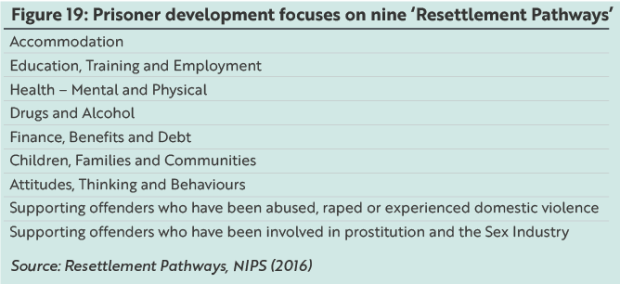
4.4 Dedicated multi-disciplinary teams of NIPS and PBNI staff work in Prisoner Development Units (PDU) within each NIPS prison, and all participating offenders are assigned a Co-ordinator to manage their PDP, initiate referrals to services and monitor progress.
This current rehabilitation approach emerged after significant criticism of NIPS in 2011 and, whilst some improvement had been identified, more recent performance slippage indicates that further work is required
4.5 The PDM approach was developed following a highly critical review of NIPS in 2011 which, amongst other things, recommended significant policy changes towards an offender-centred and desistance-based approach to managing and rehabilitating custodial prisoners. Despite NIPS implementing a significant prison reform programme following the 2011 review, CJI inspections indicated that, initially, this was not necessarily delivering a substantively improved prison environment. Four highly critical inspection reports, issued between 2013 and 2016, identified significant concerns around safety and service provision across various NIPS prisons.
4.6 NIPS subsequently introduced a three-year continuous improvement strategy ‘Prisons 2020’ in July 2018, which aimed to create a modern and affordable prison service, capable of rehabilitating those in its care. This continued focus on formal reform by NIPS may have contributed to some improvement, with CJI reporting progress in the four healthy prison tests by 2020 (Figure 20). In particular, rehabilitation and resettlement work was assessed as ‘good’ (the highest score) across the three prison sites, although ‘purposeful activity’ (prisoner engagement in activities likely to benefit them, including learning and skills) still required improvement. However, a 2022 inspection at Magilligan later identified performance slippage reflecting, to a large extent, the impact of the pandemic, although the report also highlighted wider challenges for the prison service, including the effectiveness of the prison’s drug and alcohol strategy, and the standards of cleanliness in some parts of the prison. CJI is also due to report on a recent inspection at Maghaberry in 2023.
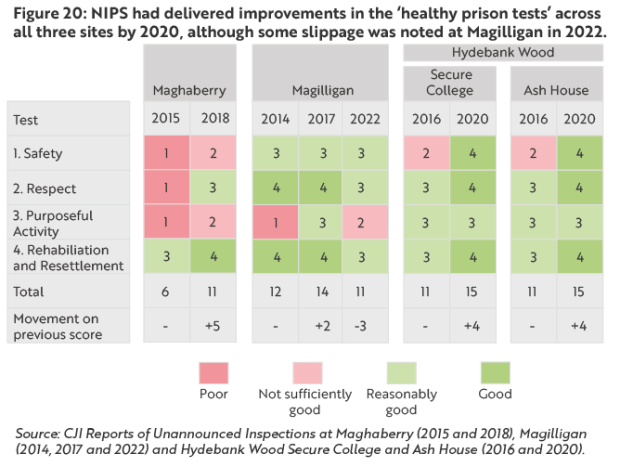
4.7 It is vital, therefore, that NIPS maintains a focus on continuous improvement as it continues its Covid-recovery journey, and this should include promptly implementing recommendations made by CJI. It has recently published a refreshed ‘Prisons 25 by 25’ strategy, which aims to progress 25 key work areas between 2022-25, including improving rehabilitation services by focusing on assessment, mental health, addictions, tailored pathways, and learning and skills. It recognises, however, that uncertainty around the budget position and continued pandemic challenges may hinder the delivery of this strategy, meaning that implementation will need to be closely monitored.
PBNI mostly operates in the community but also has a role in custodial settings with long-term prisoners
4.8 PBNI seeks to reduce reoffending by tackling associated root causes and rehabilitating people. It works: in courts, providing pre-sentence reports to assist judges with sentencing decisions; in communities, supervising court orders; and in prisons, preparing licensed prisoners for release. PBNI supervises around 4,000 offenders annually, over 85 per cent of whom are community-based offenders (subject to either community-based orders or post-custody licence supervision), with the remainder being custodial prisoners.
4.9 Over 80 per cent of supervised community orders are completed successfully each year. Research shows that positive professional relationships between offenders and probation officers support behavioural change and reduce reoffending or breaches of orders. Probation officers are qualified social workers who:
- coordinate case management;
- complete risk assessments to inform sentencing, including requirements for controls such as approved premises, electronic monitoring or curfews;
- arrange rehabilitative interventions;
- monitor lifestyles and adherence to licence conditions; and
- hold individuals to account, including taking enforcement action for non-compliance.
4.10 CJI inspections of probation practice in NI have been largely positive in relation to the quality of service provision by PBNI, although a 2020 inspection identified some areas for improvement relating to governance, culture and morale, restorative practice and consistency of good quality assessment and case management, particularly relating to the risk of harm. PBNI has been working to address these issues.
4.11 Within prisons, probation officers work alongside NIPS staff helping to deliver PDPs and working with prisoners as they approach release, to help their transition to the community. Numerous reviews have highlighted the NIPS/PBNI relationship as critical to successful rehabilitation and resettlement. However, in 2018, CJI inspectors identified that changes to joint working practices, driven by funding cuts, meant that the PDM was not operating as effectively as required.
4.12 Subsequently, NIPS and PBNI have been working together to identify proposals to enhance joint working, particularly around collaboration from the outset of a custodial sentence for licence cases, rather than waiting until closer to release. In November 2019, five additional prison-based probation staff were appointed to support this, however the pandemic has had a significant impact on the operation of the PDUs, with access restrictions, staff absences and redeployment of NIPS PDU staff to mainstream duties affecting the timeliness of assessments and delivery of rehabilitation programmes. Stakeholders reported that, as a result, there remain significant backlogs and waiting lists, although NIPS is unable to quantify these.
Both NIPS and PBNI assess reoffending risks and criminogenic needs, to determine the rehabilitation response
4.13 PBNI and NIPS develop and administer individual sentence plans based on a ‘Risk Need Responsivity’ (RNR) approach, using primarily, since 2000, the ‘Assessment, Case Management and Evaluation’ (ACE) methodology. Alongside the professional judgement of probation officers, ACE helps evaluate an individual’s risk, needs and likelihood of reoffending within two years. Assessors distinguish between general problem factors and those specifically related to offending across three domains (Figure 21), with interventions proportionate to identified risk levels (low, medium or high).
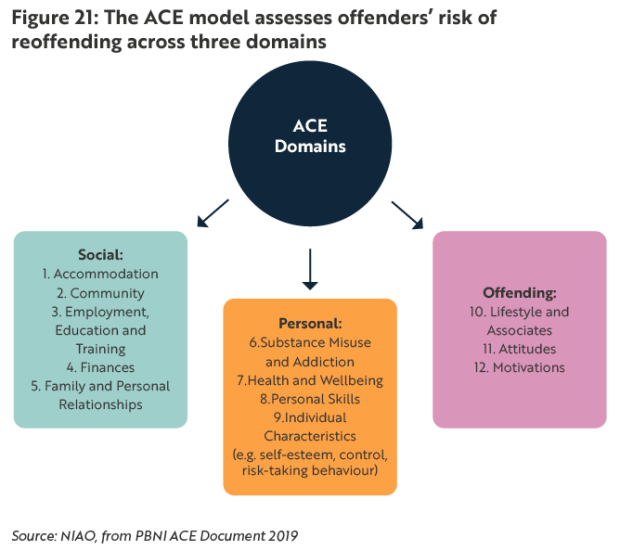
4.14 ACE may be used for court convictions to assist PBNI in preparing pre-sentence reports (PSRs), where requested by a judge. Post-sentencing, it helps to plan and target support needs and assess progress against sentence plans. Individuals assessed as having a low likelihood of reoffending will receive minimal intervention across the pathways, in comparison with those assessed as being of higher risk.
4.15 Changes in ACE scores over an offender’s sentence or order help measure if reoffending risks reduce. We obtained ACE data from PBNI covering the period 2017-2021. While this was insufficiently robust by itself to firmly assess the impact of individual statutory interventions, high level analysis (Figure 22) indicated reduced risk for 61 per cent of clients. Interestingly, almost a third of offenders exhibited increased reoffending risk, indicating how changes in personal and social factors can influence such risks.
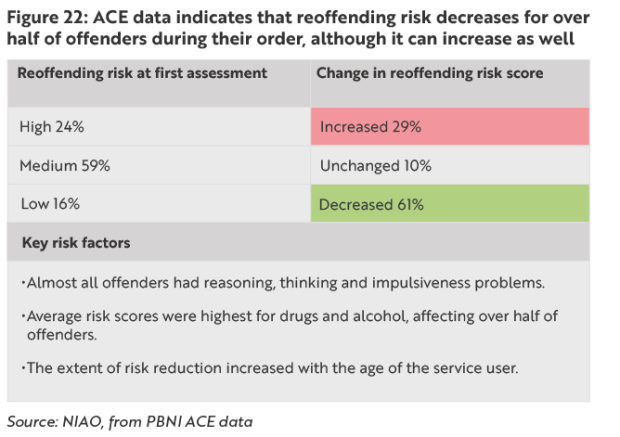
4.16 The ACE methodology, where completed appropriately, could produce useful and comprehensive information that could valuably inform strategic decision-making and policy, but it is not currently being utilised for this purpose. However, PBNI is cautious about extending the use of ACE data given the limitations of the methodology, particularly the subjective nature of the assessments, and is currently exploring other risk assessment tools with a potentially increased level of validity. It previously analysed the data to identify the prevalence of the various social, personal and offending related issues amongst clients starting an order, but has not done so since 2017-18, and has never sought to cross-reference the data to reoffending outcomes. In our view, scope exists to expand the use of such data and should be considered in terms of making better use of existing management information.
Recommendation 7
The Department should explore an increased use of the management information available to it. Working with the PBNI, this should include data from offenders’ risk of reoffending assessments, to monitor trends in client profiles and assess the impact of specific interventions on reoffending risk and subsequent outcomes. In support of this, PBNI should evaluate and conclude on the continued effectiveness of the Assessment, Case Management and Evaluation (ACE) methodology, in comparison to other risk assessment tools available.
The VCS and further education sector also have a role in providing important rehabilitation services across the desistance pathways, although scope exists for improving how some of these are commissioned
4.17 As paragraph 1.25 noted, many systemic problems influencing reoffending are outside the justice system’s direct control, and working collaboratively with statutory and other providers is necessary to ensure effective arrangements for assessing individuals and facilitating service provision whilst offenders navigate the justice system. Some of this work focuses on advice, signposting and linking into relevant services. For example, for financial matters, offenders may be referred to Department for Communities (DfC) to access benefits, or to NIACRO or Advice NI for welfare and debt advice.
4.18 However, NIPS and PBNI also offer tailored interventions to address specific needs, such as substance misuse, offending behaviour, family support or employability. In addition to programmes delivered internally, some are contracted to other government bodies (primarily further education colleges) and third sector providers at an annual cost of around £7.4 million (£5.4 million spent by NIPS and £2.0 million by PBNI). Appendix 3 lists the funded organisations within each of these sectors.
4.19 Funding for VCS groups is agreed on an annual basis, with such stakeholders reporting that short-term allocations create difficulties in recruiting and retaining staff and therefore impede their ability to effectively plan and resource their programmes. However, longer-term funding arrangements for the VCS are not currently possible in the context of annual governmental budgets. Justice organisations accept, however, that there would be benefit in a more holistic justice-wide approach to the commissioning of VCS services, and some scope exists to better ensure contracted services align with business priorities and meet current rehabilitation needs to reduce reoffending. In addition, work is required to improve monitoring of reoffending outcomes so that statutory partners are better informed as to whether these programmes are achieving their aims.
Challenges in each of the key desistance pathways are preventing effective rehabilitation
4.20 Our fieldwork included a review of individual cases involving major changes to ACE scores over the course of an offender’s order (paragraph 4.13 to 4.16). Two examples (Figure 23) clearly illustrate how the desistance pathways, particularly in relation to accommodation, employability, mental health and substance misuse, can either support or undermine offender rehabilitation.
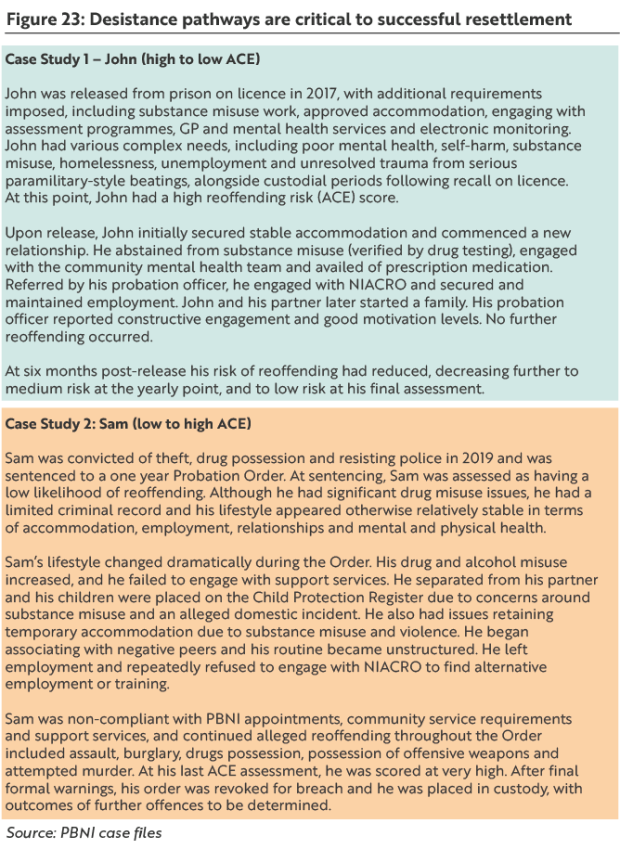
Inadequate suitable accommodation creates difficulties in rehousing offenders
4.21 Clear links exist between homelessness and reoffending. Our stakeholder engagement also found strong consensus that inadequate stable accommodation was the greatest barrier to desistance, given that an address is key to accessing services including healthcare and employment. NIPS statistics show a deteriorating picture, with 16 per cent (over 600 individuals) leaving prison in 2019-20 with no identified accommodation, compared with 11 per cent in 2015-16. Data for longer-term accommodation outcomes is not available. Outcome measurement is examined further in Part 5.
4.22 Evidence suggests that providing targeted help with accommodation impacts positively on reoffending rates, with stable homes for ex-prisoners potentially reducing reoffending by as much as a fifth. Since 2009, managing accommodation and associated needs of custodial offenders has been governed by a multi-agency protocol between NIHE, NIPS, PBNI, Housing Rights (HR) and NIACRO. This outlines actions required at different stages of prison life (Figure 24), alongside timeframes and lead responsibility for each action.
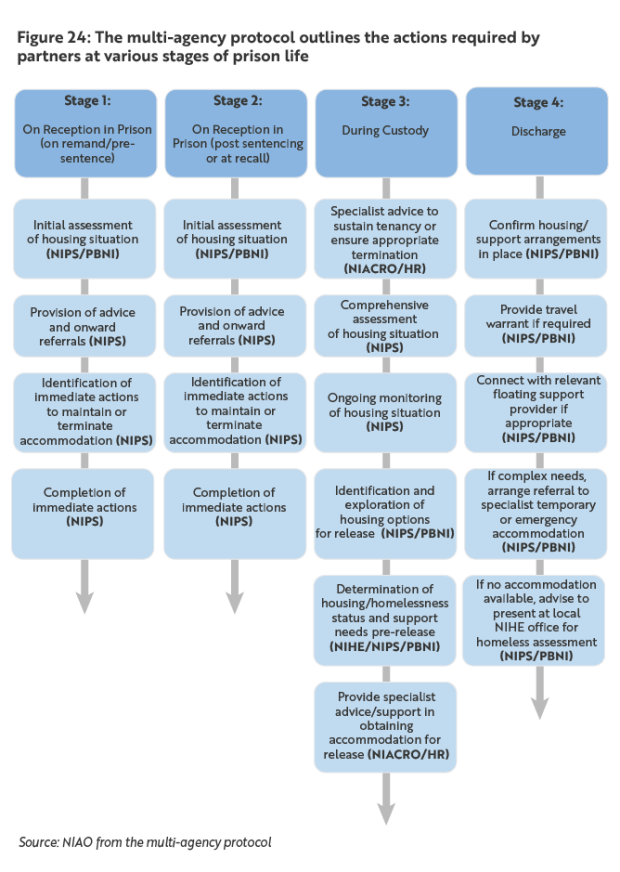
4.23 Until recently, there had been no comprehensive analysis of how the protocol has been implemented in practice, or of its effectiveness in securing accommodation. Stakeholders highlighted that although it clearly defines processes, real life experiences are often different. The protocol is currently under review, with the objective of establishing improved data sharing and access to temporary accommodation, and more practical operational interagency arrangements.
4.24 A major 2021 study into prisoners’ accommodation post-release identified key weaknesses with current arrangements (Appendix 4). Successful resettlement is hampered by a lack of supply of social housing stock, and availability and affordability of private tenancies. The complex behavioural issues which offenders often have also creates major challenges in accommodating them safely in hostels or other temporary accommodation. Gaps in transitional support to aid resettlement and retention of accommodation were also highlighted.
4.25 Stakeholders repeatedly raised these issues throughout our review. Difficulties housing and resettling offenders were also emphasised due to the disconnect between the justice, health, and housing systems (Figure 25 provides a recent case study), with particular problems noted for those released from custody after 5pm on a Friday, due to the limited availability of housing and other support services over the weekend. Whilst acknowledging the added difficulties associated with Friday releases, NIHE told us that an Out of Hours Emergency Service is available to ensure it continues to meet its statutory duty.
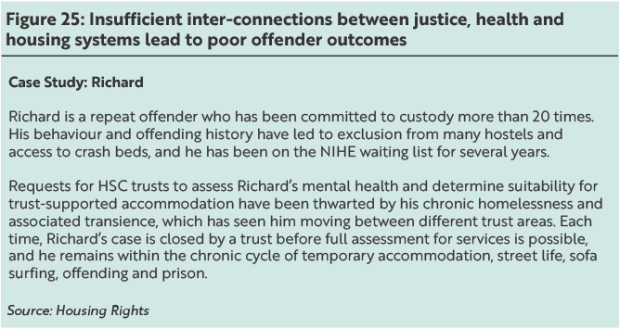
4.26 Whilst DoJ is currently considering the 2021 study’s recommendations, dealing effectively with these issues requires a multi-agency response. It is therefore important that the revised protocol (paragraph 4.23) is developed, in conjunction with all relevant stakeholders, to identify and implement adequate solutions to the problems highlighted by the study.
4.27 Smooth transition from custody to independent living assists successful resettlement, but can often be a major transition. Step-down accommodation allows prisoners to prepare for release by spending time under assessment in community-type conditions. CJI has reported that these units contribute to better reoffending outcomes but has found that they tend to be utilised below capacity. This accommodation is currently only available to life and longer-sentence prisoners subject to pre-release testing.
4.28 Around two fifths of community-supervised offenders are also assessed as having accommodation problems when beginning their order. Where these immediate needs are left unmet, reoffending risks are heightened, and probation officers can be critical in liaising with relevant services to secure temporary or emergency accommodation.
4.29 PBNI has discretionary legal powers, subject to the approval of the Department, to directly provide probation hostels and other establishments to discharge its supervisory duties but, partly due to funding constraints, it has never enacted this power. It may also enter into arrangements with voluntary organisations to provide and maintain such hostels and, as such, it uses ‘Approved Premises’ (APs) to supervise offenders requiring enhanced monitoring, to manage the risk they present in the community. However, demand is high and, with only 91 places currently available, allocation priority is mainly given to sexual or other serious offenders due for release under the Public Protection Arrangements for Northern Ireland (PPANI). Stakeholders stated that current provision should be sufficient for PPANI offenders, but that the challenges associated with exit planning for follow-on accommodation means placements often become more longer-term than required. CJI reported on the operation of APs in March 2023 and, in line with previous inspection reports, was supportive of their role in managing risk and resettling offenders, but also made a number of recommendations for improvement.
4.30 Whilst stakeholders highlighted the potential benefits of expanding stepdown or AP-type accommodation to other offender groups, particularly those with complex mental health or addiction issues, this would require significant additional investment. It is important, however, that forward planning for this type of accommodation is adequate to ensure places available, and supporting resources, are fully utilised.
Initiatives within prisons have sought to improve offender employability but learning and skills provision gaps remain
4.31 Sustained employment also contributes to reducing reoffending. Offenders typically have relatively low literacy, language and numeracy skills levels, and are much more likely to be unemployed. Whilst local data on offender employability and associated benefits is limited, MoJ analysis shows that only 13 per cent of prison leavers in England and Wales are employed six weeks post-release, rising to 17 per cent at six months, with 39 per cent of community order offenders employed at six months post-sentence completion. Reoffending rates for offenders with known employment spells following release from custody were found to be up to nine per cent lower than those with no known employment.
4.32 Resource constraints have curtailed DoJ in developing a formal employability strategy, but it established an Employability Working Group in June 2021 to provide strategic direction in this area. The Group has recently supported collaborative initiatives including:
- embedding DfC work coaches in prisons;
- working with DfC to develop a justice pilot of the JobStart Scheme for convicted 16 to 24 year olds;
- funding the ‘Ban the Box’ Campaign which encourages employers to remove criminal record checkboxes from job applications and only require disclosure of convictions later in the recruitment process;
- supporting social enterprises that employ offenders;
- encouraging employers to use social clauses in contracts to engage ex-offenders; and
- exploring potential for a local pilot of the Going Forward into Employment project.
4.33 These are important initiatives, but an absence of routine outcome monitoring means DoJ is unsighted on their impact in enhancing offenders’ employability. Part Five considers outcome measurement.
4.34 Prisoner learning also positively influences post-release employment outcomes. Since the 2011 review of NIPS criticised this area, NIPS has significantly enhanced education and training provision. In 2017, learning and skills provision across the three prison sites was outsourced to Belfast Metropolitan College (BMC) and North-West Regional College (NWRC), with learning and skills centres now embedded within each NIPS prison, offering training and accredited qualifications across 30 categories (Appendix 5). Prisoner learning and skills registrations have subsequently increased by almost 25 per cent between 2016-17 and 2019-20, from 1,870 to 2,320.
4.35 However, scope remains for further improvement. Recent CJI inspections in Maghaberry (2018) and Magilligan (2022) assessed prisoner outcomes for ‘purposeful activity’ (including learning and skills) as ‘not sufficiently good’ (paragraph 4.6), with various concerns highlighted including, for example, the curriculum being too narrow, long waiting lists for popular courses, insufficient focus on improving literacy, numeracy and ICT skills, and limited contact with employers and the workplace.
4.36 A new Service Level Agreement (SLA), with BMC as lead college, was signed in April 2021 at an annual cost of around £3.5 million. This requires individual learning plans for each prisoner engaging with services, covering essential skills, vocational training, work experience and personal and social development, to provide education and support from committal through to employment or further education post-release. Future CJI inspections will help assess the impact of these new developments on service delivery post-pandemic.
Accessing health and social care services can be problematic for offenders and further action is required on mental health issues and substance misuse
4.37 Whilst community-supervised offenders access mainstream health and social care services, DoH has overall responsibility for health care policy in prison and, since 2008, the South Eastern Health and Social Care Trust (SEHSCT) has delivered primary care, mental health, and addiction services to all prisoners across the three adult prison sites.
4.38 Mental health issues impact significantly on offenders. Over a third of local prisoners were recently reported as having a confirmed mental health issue, and almost 45 per cent of those on probation have some level of assessed mental health problems which contribute to their offending. In 2019, we reported that the justice system had been unable to meet its mental health responsibilities consistently in a way that supported rehabilitation objectives, and had found it difficult to address the increasing prevalence of offender mental health issues.
4.39 In June 2019, DoJ and DoH published a joint five-year strategy and action plan aimed at addressing gaps in support and improving health across all stages of the criminal justice journey, and thereby reducing offending behaviour. Delivery of the initial three-year action plan was impeded by COVID-19 and, in March 2022, a group established to oversee its implementation agreed that it should be extended by a further year so that various actions could be fully progressed. A refreshed two-year plan is under development and expected to be in place in the latter half of 2023.
4.40 It is important, however, that any future action plan takes account of issues raised recently by the Regulation and Quality Improvement Authority (RQIA) regarding the care provided for vulnerable prisoners in NI. In 2021, whilst estimating that local prison healthcare is underfunded by approximately £4 million per annum in comparison to England and Wales, it reported that further improvement is needed in how services are commissioned, planned and delivered within prisons. In particular, it found that services are under considerable pressure, with demand greatly exceeding capacity, long waiting times for mental health and addiction appointments and for transfer to acute mental health beds within hospital, alongside a significant lack of psychological support for people with a history of personality disorder and trauma. RQIA made 16 recommendations which it said, if fully implemented, would support better outcomes for vulnerable prisoners, including reduced reoffending.
4.41 Our stakeholder engagement also highlighted potential benefits in greater HSC involvement within court processes, in seeking to divert offenders or helping devise appropriate sentencing to reflect issues, including mental health concerns, similar to Liaison and Diversion services in England and Wales (para 3.54). As paragraph 2.12 noted, the PSJ strategy included plans to develop, in conjunction with DoH, a Mental Health Court (MHC) pilot to try and tackle offending behaviour through tailored community-based orders providing specific support for offenders with mental health issues. DoJ told us that these plans did not progress due to the COVID-19 pandemic. It is currently working with DoH to try to identify alternative approaches that can be delivered within existing budgets, given funding and capacity constraints. The high prevalence of mental health issues amongst offenders, and the further detrimental impact of prison sentences on mental health, mean that a viable community-based approach needs to be promptly identified.
4.42 Thinking, behaviour and attitude issues are also common among offenders, and these impair their ability to make positive life choices (Figure 26). NIPS and PBNI have internal psychology departments which, working alongside HSC professionals, carry out assessments, provide specialist advice and deliver cognitive behavioural interventions aimed at reducing reoffending. This helps to circumvent long potential waits for HSC services, and includes specific programmes addressing domestic abuse and sexual and violent offending, alongside developing motivation, thinking and pro-social skills. Most of these programmes are accredited by His Majesty’s Prison and Probation Service (HMPPS).
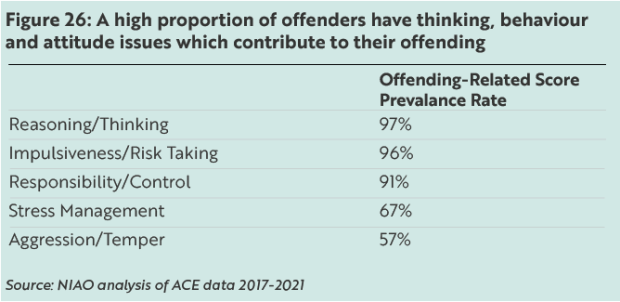
4.43 Reviews since 2011 have repeatedly recommended that NIPS and PBNI share resources, particularly within forensic and clinical psychology services, and those required to deliver specialised assessments and interventions. Whilst some collaborative work has been undertaken to determine the scope for alignment of processes, progress in delivering actual integration has been minimal. Better integration could potentially deliver cost savings through reducing duplication of service provision, and improve outcomes for offenders through streamlined processes. This work should therefore be progressed without further delay.
4.44 Over half of supervised offenders also have drug or alcohol problems, and 66 per cent of prisoners report having used drugs (paragraph 1.21). Successful completion of drug and alcohol treatment rehabilitation programmes has been linked to lower reoffending risk. Locally, the SEHSCT employs an addictions consultant and nursing staff and provides an addiction support service through AD:EPT, while the justice system funds further support through VCS custody and community programmes (Appendix 3).
4.45 Alongside targeted support, preventing drugs being smuggled into prisons is key to rehabilitating offenders with addiction issues, and ensuring prisoner and staff safety. A 2018 inspection of Maghaberry found that availability of illegal drugs had been successfully reduced, however concerns were subsequently raised in 2022 at Magilligan due to high positive test levels and inadequate oversight of in-possession medication. Whilst highlighting that an action plan to tackle these issues had been introduced, CJI stated NIPS had not yet addressed drug supply within the prison. Its recent inspection at Maghaberry, due to be published later in 2023, will also cover aspects of this. The Department told us that, between March and April 2023, NIPS introduced X-ray body scanning technology across the three prison sites, which it anticipates will significantly assist in disrupting drugs being smuggled into prison.
4.46 The Substance Misuse Court (SMC) (paragraph 2.12) has been developed by NICTS to specifically target drug and alcohol linked offending behaviour within the community. The SMC involves intervention services delivered by PBNI and Addiction NI, including substance testing, therapeutic intervention, access to social support and regular court attendance. If completed successfully, final sentencing reflects offender participation.
4.47 Initial pilots were completed between April 2018 and March 2021 at Laganside Magistrates’ Court in Belfast. NISRA evaluations found significant reductions in participant problem drug and alcohol misuse and reoffending risk, and increases in self-efficacy and wellbeing. Results also indicated that, over the longer-term, those who successfully completed the programme exhibit lower reoffending rates than those who did not. However, statistics provided by PBNI show that, as at 31 October 2022, 513 referrals had been made to the SMC, of which 278 (54 per cent) were assessed as unsuitable, 35 (7 per cent) were under current assessment, and 200 (39 per cent) were approved for participation. Of the 200 participants, 81 (40 per cent) completed the programme, 25 (13 per cent) were still active, and 94 (47 per cent) were removed. In our view, the relatively low numbers approved for participation, and subsequent low completion rates, indicates that further evaluation of the initiative is required to conclude whether it is suitably designed or resourced to address the needs of the target cohort.
4.48 Full roll-out of the SMC was initially planned for 2022-23, but budgetary constraints have again hindered further progress in developing a plan for this. As such, participation remains restricted to Belfast Magistrates’ Court, where it has been embedded in normal rostered business since April 2021, creating disparity of service provision. The SMC costs approximately £500,000 annually to deliver, but analysis of the pilot has not yet assessed cost-effectiveness. This is also critical to inform final decisions on further roll-out, and full evaluation should be completed promptly.
Recommendation 8
The Department should appraise the overall participation and completion rates, and associated cost-effectiveness, of the Substance Misuse Court (SMC), to inform further roll-out. As plans to pilot a Mental Health Court (MHC) have not progressed, the Department should expedite identification of alternative problem-solving approaches to mental health issues for those in contact with the justice system. An invest-to-save approach should be adopted where initiatives such as these are assessed to deliver net economic benefits.
Intensive support models, particularly where targeted at high-risk reoffending groups, can yield benefits but resource constraints often curtail their impact
4.49 Making significant inroads into reducing reoffending rates requires the justice system to focus on interventions with proven success and targeted at the highest risk of reoffending groups. The case studies at Figure 27 and Figure 28 illustrate how statutory stakeholders have sought to achieve this, through initiatives based on intensive models of support directed at high-risk cohorts.
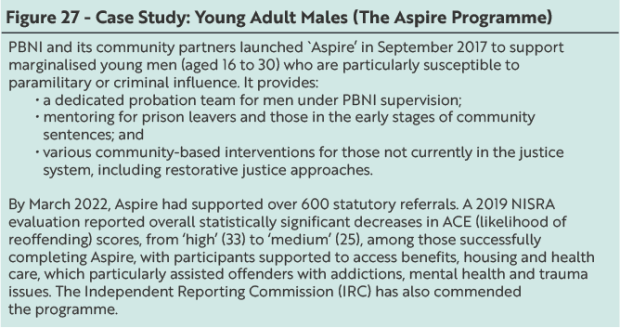
4.50 Similar to the SMC (paragraph 4.46), the cost-effectiveness of Aspire is unknown, as an economic evaluation has not yet been completed, despite £6.8 million being provided between 2016-17 and 2022-23 to deliver it. In addition, the NISRA evaluation did not assess actual reoffending outcomes, meaning justice partners cannot currently measure its true balance of costs and benefits in reducing reoffending. It is also unclear how, or if, this work will continue once programme funding ceases in 2024.
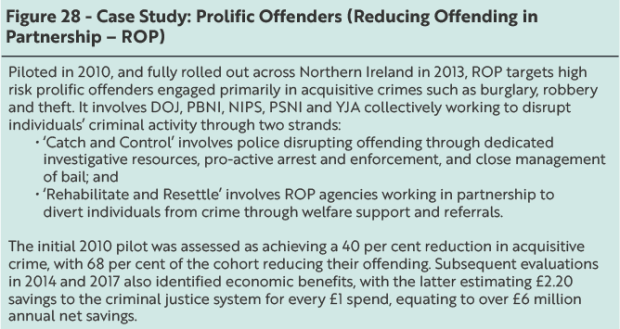
4.51 ROP focusses primarily on those engaged in acquisitive crimes, but limited available funding means it can only currently support around 200 service users simultaneously. Although positively evaluated, PSNI is considering how the programme can be further enhanced to deliver improved outcomes through closer alignment with the new Integrated Offender Management (IOM) model introduced in England and Wales in 2021, with aspirations to deliver more clearly defined roles and responsibilities for key partners and better collaboration with HSC trusts.
4.52 In addition to Aspire and ROP, this review has highlighted benefits delivered by other targeted intensive support initiatives, including ECO (paragraphs 3.21 to 3.26) and SMC (para 4.46 to 4.48). Two further programmes, RESET and Beyond the Gate, are summarised at Figure 29.
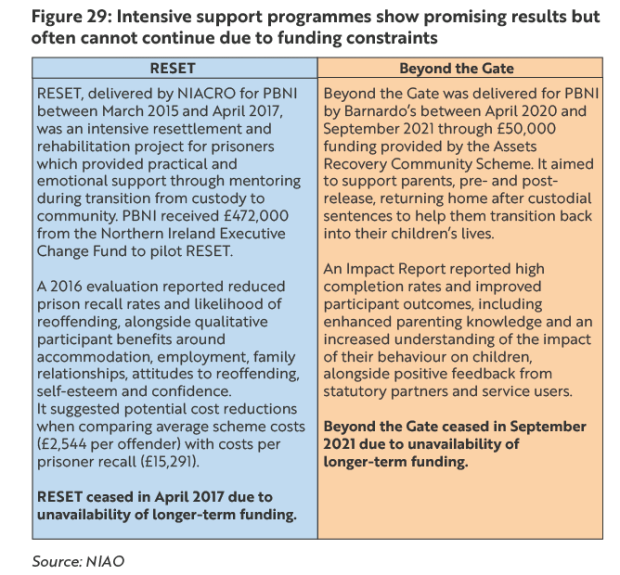
4.53 Intensive support programmes have demonstrated beneficial outcomes, however these programmes are resource intensive and expensive to deliver, and roll-out or widespread implementation is subject to affordability, which is problematic in a tight financial climate. This problem is heightened by the short-term nature of resourcing arrangements, as a result of public bodies operating under annual budgets, and a reliance on non-budget temporary funding streams to deliver innovative programmes and pilot projects. Successful programmes therefore often cannot continue, or are restricted to small distinct cohorts, hampering wider efforts to reduce reoffending.
4.54 In circumstances where many projects cannot be expanded, developing an effective longer-term delivery plan becomes challenging, and pilots are destined to fall short of their true potential from the outset. In the absence of additional resources, a review of the critical success factors associated with these programmes may assist in identifying the most successful initiatives which available funding should be directed towards, alongside identifying common areas of good practice which could be mainstreamed into current service provision.
“Our stakeholder engagement found strong consensus that inadequate stable accommodation was the greatest arrier to desistance, given that an address is key to accessing services including healthcare and employment.” – Northern Ireland Audit Office
Part Five: Assessing performance and measuring outcomes
Assessing performance and measuring outcomes
Reducing reoffending was established as a key strategic area within the draft Programme for Government 2016-21
5.1 In 2014, the NI Executive engaged the Organisation for Economic Cooperation and Development (OECD) to assess its public sector reform agenda. A key recommendation in OECD’s subsequent ‘Joined up Governance’ report was for the Executive to develop a multi-year outcomes-based PfG, framed by a vision for NI’s people and its economy.
5.2 Based upon an Outcomes Based Accountability (OBA) approach, the Executive subsequently developed its draft PfG 2016-21, with 14 anticipated outcomes setting out the wellbeing aspirations for the NI population. This represented a fundamental shift in local public service delivery, placing a stronger emphasis on outcappendix 2omes for the public, with less focus on organisations’ inputs, processes and outputs. Outcome 7 of the draft PfG, and subsequent ODP developed by the NICS (paragraph 2.6), had the aspiration that `we have a safe community where we respect the law and each other’, with the reoffending rate established as one of five indicators to be evaluated to measure success (Figure 30).
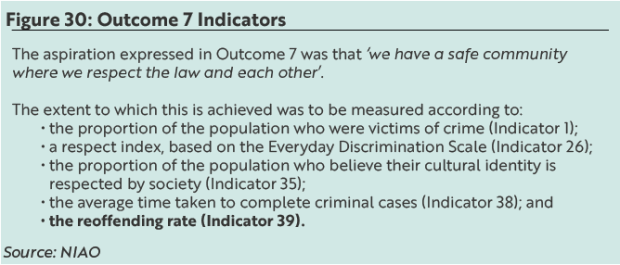
5.3 The OBA approach aims to ‘turn the curve’ by outperforming current trajectories, and progress was to be monitored against baselines for each indicator established by NISRA. As paragraph 1.12 noted, the local adult reoffending rate stood at 16.0 per cent in 2019-20, falling below the 2013-14 baseline of 17.3 per cent. However, prior to this, the rate had slightly increased since 2013-14 (to 17.9 per cent in 2018-19), with the COVID-19 pandemic potentially influencing this more recent trend, although more detailed analysis of its impact is required to understand this. In our view, it is therefore difficult to conclude whether the various statutory initiatives to reduce reoffending, whilst often demonstrating positive results individually, are achieving the desired overall outcome. The Department has, however, highlighted that the falling numbers of offenders and reoffenders within the cohorts over the period indicates some success, but that a residual group of ‘hard to reach’ and/or prolific offenders continue to present particular challenges in delivering further or faster reductions in the reoffending rate (paragraph 1.16).
Better performance measures and targets are needed to monitor success in reducing reoffending
5.4 Measuring reoffending performance is inherently difficult, particularly given the numerous activities and justice organisations involved, alongside contributory initiatives delivered across other government areas including health, housing and education, and by third sector bodies. Nevertheless, for OBA to be successful, public organisations must demonstrate and quantify how the public benefits from the services they deliver and, by extension, their contribution to achieving desired outcomes.
5.5 However, as we have previously reported, the link between the PfG indicators and how individual initiatives aimed at supporting their delivery are evaluated is tenuous, and therefore the specific contribution of individual actions to PfG Outcome 7 and Indicator 39 cannot be quantified. The Executive Office (TEO) told us that the indicators were not designed to be attributable to initiatives or organisations, but rather to give an indication of society’s collective direction of travel towards an outcome.
5.6 This, however, creates difficulties for the lead departments in demonstrating improvement arising from their investment in the area and, therefore, requires the development of clearly defined and meaningful performance measures to underpin their work. Despite this, the justice system has not yet succeeded in developing such measures, nor has it set supporting targets which prescribe a specific required reduction in reoffending rates (paragraph 1.11), or quantified improvements in related factors, including post-sentence employment or accommodation. In our view, the absence of an overarching and current strategy for reducing reoffending (paragraphs 2.7 to 2.9) under the PfG is likely to have prevented greater focus on this area.
5.7 Although DoJ’s Business Plans have included reducing reoffending within the ‘Challenge Offending Behaviours and Support Rehabilitation’ strategic theme, the absence of measures to evaluate impact mirrors the situation in NIPS and PBNI. CJI has repeatedly highlighted the need for improved performance measures that indicate achievement of longer-term outcomes, to allow management to assess effectiveness of service provision and plan future delivery and resourcing. It has particularly stated that this ‘must be addressed in the action plans of the [Criminal Justice Sector] agencies’.
England and Wales have committed significant funding to target and resource reoffending initiatives and measure wider performance, but NI lags far behind this
5.8 MoJ’s Outcome Delivery Plan for England and Wales included three performance metrics which underpin its ‘reduce reoffending’ outcome, focussed on the percentage of prisoners in employment, settled accommodation or having successfully undertaken substance misuse treatment post-release. HMPPS’s Regional Reducing Reoffending Plans (paragraph 2.10) also contain region-specific targets and the use of performance data to assess outcomes in these areas. These regional plans are supported by substantial investment over a three-year period from 2022 to 2025 (totalling £470 million per annum by 2024-25).
5.9 In contrast, the NI justice system continues to operate within tight financial constraints. In real terms, DoJ told us that its budget is around £300 million below where it would currently be had it kept pace with inflation. Whilst reducing resources will undoubtedly restrict DoJ’s response to reoffending, they highlight the importance of utilising scarce resources efficiently by prioritising services which are delivering the best outcomes most cost-effectively. Enhanced performance measures are therefore critical to understanding whether initiatives have delivered intended outcomes, and determining which programmes should continue, be amended or ceased. Until these are developed and introduced, the justice system cannot fully demonstrate value for money in this area.
Improved information and outcome measurement is necessary to better understand performance
5.10 To measure outcomes, public bodies require good quality and relevant datasets. This enhances their ability to analyse trends and compare performance, and better understand what indicators can serve as useful and meaningful government performance targets.
5.11 Benchmarking local reoffending levels with the rest of the UK and the RoI would provide valuable analysis on local performance and respective trends, but meaningful comparison is not feasible due to the various jurisdictions measuring and reporting outcomes differently. Whilst Scotland and RoI measurement varies significantly from the local methodologies, England and Wales use a broadly similar `one-year proven re-offending’ rate. However, differences in the types and categories of offences included, and in the criminal justice systems and offender characteristics, mean that benchmarking has significant limitations.
5.12 In 2012, MoJ highlighted the difficulties in comparing international justice systems, commenting that “as reoffending is such a key measure, it would be highly desirable if more resources could be put into comparing rates in different countries, or producing a one-off or regular international survey.” DoJ previously published adjusted reoffending rates, alongside actual rates, to align with those in the UK but it told us that, following changes in UK methodology and consultation with users of the statistics locally, the adjusted rate was removed from the publication from the 2017-18 cohort onwards as it was no longer comparable with UK figures or considered beneficial to users. While devising meaningful benchmarks for measuring performance against other jurisdictions could aid future analysis and decision-making, DoJ advised that this is not currently possible due largely to resource constraints. Furthermore, it considers that keeping pace with changes elsewhere is not a practical use of limited resources, and there are added constraints associated with smaller volumes of data locally in comparison with other jurisdictions.
5.13 Local statistics are also produced with a time lag of around eighteen months (to allow for the reoffending interval and return to court processing time, alongside data analysis). The delay in publishing reoffending figures creates an additional challenge for justice bodies in assessing how their actions in any given year impact on reoffending rates. By comparison, England and Wales have developed quarterly reoffending reporting arrangements, thereby providing more timely information to decision-makers.
5.14 In 2019, MoJ reported that ‘proven reoffending has limitations as an outcome measure.’ In particular, it does not reflect the severity of reoffending or the impact on victims. Some stakeholders told us that supplementary measures which consider risk reduction (in terms of frequency or severity of offending), or ‘distance travelled’, may better measure progress than solely relying on reoffending rates.
5.15 The reoffending rate also does not reflect other successful outcomes, including entry into employment or education, desistance from problem drug use, improved family and peer relationships, or acquiring permanent housing. The UK Government has enhanced outcome reporting in this area by publishing quarterly accommodation and employment outcomes data for offenders from March 2019, moving to an annual publication from 2021-22. There are currently no comparable measurements for NI.
5.16 Local systems do not capture all the data needed to measure wider outcomes, and progress is constrained by inadequate integration of systems and restrictions on data sharing. In April 2018, DoJ initiated work to try and secure access, through NISRA, to linked data through the Administrative Data Research (ADR-NI) initiative on outcomes such as benefits, accommodation, employment, and mortality, however progress has been slow due to lengthy and complex processes to obtain ethical and legislative approvals. Whilst the Department was successful in obtaining the necessary approvals, it highlighted that it has subsequently been restricted by the parameters set by ADR-NI and data owners in facilitating its work. Therefore, in the interests of developing a proof of concept to allow a more detailed consideration of wider work, an initial study is ongoing, analysing post custody deaths using NIPS data and death registrations.
5.17 Limited data can significantly impede progress, hindering identification and measurement of key and successful outcomes. DoJ and wider government must therefore work together to resolve data sharing issues and progress better access to data so that any future research can link into wider datasets.
5.18 Problems with outcome measurement are longstanding, and justice bodies accept the need for improvements. CJI has consistently reported that the justice system is effective in measuring inputs and outputs, and reporting on activities, but less so in measuring impacts or achievement of outcomes. Going forward into a new PfG, the justice sector needs to consider how it can improve data collection and outcome measurement to enable it to demonstrate effectively its contribution towards, and impact on, overall strategic outcomes.
Progress is hindered by the absence of an up-to-date Programme for Government
5.19 The newly reformed Executive commenced work on developing a new strategic, outcomes-based PfG in early 2020. Public consultation on the new draft framework, between January and March 2021, demonstrated broad support for nine proposed Outcomes, including one similar to the former Outcome 7. A revised document was subsequently produced by officials, taking account of the feedback received, however no agreement was reached before the NI Executive collapsed again in February 2022, and efforts to develop and agree a programme of work which would constitute a PfG stopped, pending the formation of a new government.
5.20 As a result, justice bodies have continued working on delivering previously agreed actions under the ODP. However, as paragraph 2.17 noted, TEO has not reported on the ODP since the revised plan was published in December 2019 and, to date, the degree to which it successfully achieved its intended outcomes overall has not been formally assessed. Likewise, reporting against indicators by NISRA has been discontinued until a new Outcomes Framework is formally agreed. TEO told us that it will be a matter for the incoming Executive to agree the approach to any future PfG, including the reporting arrangements.
5.21 The public sector faces a period of significant uncertainty. A functioning Executive is key to improving outcomes, but the absence of agreed governmental priorities and plans, alongside the present economic climate, bring significant challenges to managing functions such as reoffending, and driving the necessary changes. Work on enhancing performance management structures and systems should commence as a matter of urgency to ensure DoJ is better placed to measure the impact of its work when new objectives are finally agreed.
Recommendation 9
The Department, with support from the wider Executive, should identify meaningful, robust and realistic outcome-based performance measures to underpin future PfG indicators. This will require appropriate baselines and procedures for monitoring and reporting of performance. In support of this, the Department should further progress wider data collection and analysis to measure its impact in key areas, such as offenders’ accommodation, employability outcomes, or desistance from drugs and alcohol.
Appendix 1: Methodology (paragraph 1.27)
Our investigation has used a combination of quantitative and qualitative methods to gather evidence.
We have reviewed extensive documentation from a range of sources, including academic research, corporate publications and policy papers and statistical, inspectorate and evaluation reports. We have also analysed published and unpublished performance data held by local criminal justice organisations and, where appropriate, have sought to benchmark this with available data across the UK.
Our understanding of the workings of the local criminal justice system has also been informed by discussions with key staff at a range of statutory justice organisations: the Department; NIPS, PBNI, PSNI, NICTS, PPS and CJI. We also engaged with members of the judiciary, including the Lady Chief Justice. Furthermore, we met with several voluntary and community sector partners, involved in the delivery of rehabilitation initiatives, including NIACRO, Barnardo’s and Housing Rights.
Appendix 2: Estimate of funding directed towards addressing reoffending and rehabilitation by NIPS and PBNI (paragraph 2.24)
In 2022-23, NIPS and PBNI were allocated total opening budgets of £125 million and £24 million respectively, however this mostly relates to core services, including providing safe and secure custody, and the direct activities involved in supervising community orders. Although these contribute towards improving offender outcomes and reducing reoffending risks, only £16 million of NIPS and PBNI funding (11 per cent of their total combined budget) is allocated directly to offender rehabilitation and resettlement services.
NIPS and PBNI budgeted around £16 million for rehabilitation services in 2022-23
|
Statutory organisation and area of operations |
Summary of work undertaken / services provided |
Opening Budget for 2022-23 (£ million) |
% of annual budget |
|---|---|---|---|
|
NIPS - Psychology |
In-house psychology service to assess offenders and deliver behaviour programmes |
1.23 |
|
|
NIPS - Prisoner Development Units |
Delivery of the Prisoner Development Model (PDM) |
3.28 |
|
|
NIPS – Rehabilitation Management / Resettlement |
Management and oversight of rehabilitation initiatives to those within the care of NIPS |
0.30 |
|
|
NIPS - Funding Voluntary and Community Sector |
Funding provided to the VCS for interventions in support of reducing reoffending |
1.91 |
|
|
NIPS - Funding provided to PBNI |
Provision of prison-based probation officers to support NIPS in preparing licenced prisoners for resettlement |
1.13 |
|
|
NIPS - Funding provided to Belfast Metropolitan College |
Provision of learning and skills services across prisons |
3.48 |
|
|
Total NIPS funding |
11.33 |
9.0% |
|
|
PBNI – Psychology |
In-house psychology service to assess offenders and deliver behaviour programmes |
0.78 |
|
|
PBNI - Funding Voluntary and Community Sector |
Grants provided to the VCS for rehabilitative interventions |
2.02 |
|
|
PBNI – Funding for PSJ initiatives |
Delivery of PSJ initiatives e.g. ECO, SMC |
1.97 |
|
|
Total PBNI funding |
4.77 |
19.6% |
|
|
Overall total funding |
16.10 |
10.7% |
Appendix 3: Third-party providers funded by NIPS and PBNI to deliver rehabilitation programmes (paragraph 4.18)
A range of third-party providers are funded by NIPS to deliver programmes across the three prison sites
|
Service Provider |
Programme |
Opening Budget 2022-23 |
Services provided |
|---|---|---|---|
|
BMC and NWRC |
Learning and Skills |
£3,480,000 |
Learning and skills provision, including accredited courses, across all prisons. |
|
NIACRO |
Core funding |
£266,000 |
Contribution towards running costs. |
|
Prison Chaplaincy |
Pastoral and spiritual guidance |
£247,000 |
Church, committal and crisis services, in accordance with statutory requirements. |
|
NIACRO |
Family Links |
£206,000 |
Support for families of prisoners through advice, information packs and regular contact. |
|
Barnardo’s |
Parenting Matters [part-funded by Barnardo’s] |
£155,000 |
Support services and programmes for parents in custody to maintain or improve family relationships. |
|
Prison Arts Foundation |
Creative therapeutic engagement |
£138,000 |
Creative arts workshops for prisoners to develop attitudes, strengths and personal skills. |
|
NIACRO |
Working Well |
£131,000 |
Support to help prisoners into employment, education or training. |
|
Housing Rights |
Housing Advice Service |
£98,000 |
Housing advice and support to prisoners and coordination and delivery of peer housing advice including training of ‘peer mentors’. |
|
Various hostel providers |
Hostel |
£80,000 |
Hostel accommodation for Maghaberry prisoners on home-leave or pre-release testing. |
|
Northern Ireland Alternatives |
Core funding |
£69,000 |
Restorative practice. |
|
Community Restorative Justice Ireland |
Core funding |
£69,000 |
Restorative practice. |
|
Include Youth |
Core funding |
£58,500 |
Advocacy and support for young people to improve their employability, personal and social development. |
|
Cruse |
Bereavement support services |
£52,000 |
Assist prisoners dealing with grief to understand the process and develop coping strategies. |
|
Start 360 |
Mentoring, advocacy and support |
£52,000 |
Mentoring, advocacy and support in relation to emotional, social and behavioural issues. |
|
Advantage NI |
Quest |
£38,000 |
Employability training for young males and work experience within a social enterprise. |
|
All Lives are Precious |
Traveller Advocacy Service |
£30,000 |
Workshops for the travelling community such as literacy and numeracy, mental health awareness and suicide prevention. |
|
Prison Fellowship |
Practical, mental and emotional support |
£30,000 |
Informal counselling, restorative and bible study initiatives, and mentoring. |
|
NEXUS |
Counselling |
£30,000 |
Specialised counselling for victims of sexual violence and abuse. |
|
Action Mental Health |
Wellbeing |
£25,000 |
Provide soft-skills and personal development and assist students to engage in college training. |
|
Irish Football Association |
Staying Onside Programme |
£20,000 |
Develop coaching and refereeing skills and provide workshops for community and club development and mental health in sport. |
|
Belfast Sports Network |
Sports Activity |
£20,000 |
Training and qualification in leading and coaching activity sessions and events. |
|
Quakers |
Connections |
£20,000 |
Volunteer befriending scheme for isolated prisoners in Maghaberry. |
|
Prince’s Trust |
Enterprise Programme (for 18 to 30 year-olds) |
£15,000 |
Help young people explore opportunities for starting a business and build employability skills. |
|
Business in the Community |
Core funding |
£15,000 |
Support for employability and ‘Ban the Box’ campaign. |
|
Relate |
Counselling service |
£10,000 |
Provide a therapeutic space to address personal wellbeing and relationship issues. |
|
The Right Key |
Wellbeing |
£10,000 |
Music lessons and choir in Hydebank Wood College. |
|
Ulster GAA |
Sports Activity |
£10,000 |
Provide opportunities for prisoners to play Gaelic sports and undertake qualifications. |
|
Samaritan’s |
Telephone and emotional support scheme |
£7,500 |
24/7 telephone support service and volunteer-based peer support scheme. |
|
Women’s Aid Hostel |
Hostel |
£3,000 |
Funding to cover transport cost only. |
|
Total |
£5,385,000 |
A range of third-party providers are funded by PBNI to deliver programmes to offenders in the community
|
Service Provider |
Programme |
Opening Budget 2022-23 |
Services provided |
|---|---|---|---|
|
NIACRO |
Aspire |
£887,075 |
Restorative and community reintegration services to people subject to ECOs. |
|
Ascert |
Addiction Services |
£300,000 |
Support with alcohol, substance misuse and emotional wellbeing. |
|
Addiction NI |
Substance Misuse Court |
£164,262 |
Assessment and treatment of substance misuse issues for SMC participants. |
|
NIACRO |
Working Well |
£100,000 |
Support to help people with convictions into employment, education or training. |
|
Barnardo’s |
ECO Parenting Skills |
£100,000 |
Parenting services for people subject to ECOs. |
|
Start 360 |
Engage |
£92,000 |
Support for women, such as trauma, addictions, mental health, relationships, domestic and sexual violence. |
|
Various |
Community Service Placements |
£70,050 |
Funding to secure unpaid work placements for offenders on Community Service Orders. |
|
Women’s Aid Federation |
Domestic Abuse Perpetrators Programme |
£60,000 |
Support for women and children who have experienced domestic abuse. |
|
Start 360 |
Protect Life |
£50,000 |
Support for at-risk individuals with problem behaviours, self-harm issues and suicidal ideation. |
|
NIACRO |
Transitions |
£40,000 |
Mentoring service for men and women released from custody on licence. |
|
NI Alternatives |
Restorative Justice |
£40,000 |
Restorative and community reintegration services to people subject to ECOs. |
|
Community Restorative Justice Ireland |
Restorative Justice |
£40,000 |
Restorative and community reintegration services to people subject to ECOs. |
|
Total |
£2,023,387 |
Appendix 4: Research identified issues which impact on an ex-prisoner’s ability to access and retain accommodation (paragraph 4.24)
A study on prisoners’ accommodation post-release identified a number of issues
|
Issue |
Finding |
|---|---|
|
Availability and suitability of accommodation |
A significant proportion of prisoners are released with ‘no fixed abode’, or to short-term or unstable accommodation, leading to higher reoffending rates. |
|
Provision of housing advice |
Housing advice in prisons is generally working well but there are insufficient resources to cover all offenders requiring support, in sufficient depth and at the right time. |
|
Support moving into the community |
The Housing Rights ‘Beyond the Gate’ service is positive, but resources, reach and eligibility requirements are constricting factors. Service users’ non-housing needs (particularly health and mental health) are not always dealt with in a multi-disciplinary way prior to release and issues often arise accessing health and community services. There is inadequate support to help service users develop or retain tenancy-ready skills. Continued and ongoing support within the community is often absent. |
|
Information at the point of discharge |
NIPS’ in-house staff lack sufficient information to assist and signpost service users. Clear, accessible and readable information on accommodation is required, together with bespoke contact details for each service user on release. |
|
Accommodation options |
Service users who do not have accommodation and/or family to return to have limited options. A lack of supply of social housing stock and access to the private rental sector means temporary accommodation is often the only choice. Housing benefit regulations often restrict the ability of service users to retain their social or private rental accommodation for the duration of their prison stay. |
|
Access to temporary accommodation |
Uncertainty over the type and location of temporary accommodation service users are placed in in advance of release causes them anxiety. Temporary accommodation is often unsuitable for a service user’s need and circumstances, particularly where alcohol and drugs are problematic. |
|
Support in accommodation |
Ongoing support to retain accommodation is important but gaps exist in how this is provided for release from prison. The first 24-72 hours post-release are critical but timely support is not always available across all geographical areas. The lack of furniture and white goods, due to affordability and inadequate government financial support, can contribute to tenancy breakdown. |
Source: NIAO, from The acquisition and retention of stable accommodation by individuals released from prison, Fiona Boyle Associates, 2021
Appendix 5: A range of accredited courses is available across the prison establishments (paragraph 4.34)
Further Education Colleges offer a range of accredited courses across the prisons
|
Course Category |
Hydebank Wood |
Maghaberry |
Magilligan |
|---|---|---|---|
|
Art and design |
✓ |
✓ |
✓ |
|
Barbering |
✓ |
✓ |
✓ |
|
Barista skills |
✓ |
✓ |
|
|
Business administration |
✓ |
✓ |
|
|
Construction: |
|||
|
Bricklaying |
✓ |
||
|
Carpentry and joinery |
✓ |
✓ |
✓ |
|
Painting and decorating |
✓ |
✓ |
|
|
Plastering |
✓ |
||
|
Tiling |
✓ |
✓ |
|
|
Woodworking |
✓ |
✓ |
|
|
Contact Dermatitis |
✓ |
✓ |
|
|
Creative writing |
✓ |
||
|
Customer Service |
✓ |
||
|
Employability |
✓ |
✓ |
✓ |
|
Environmental Management |
✓ |
||
|
English |
✓ |
||
|
English for Speakers of Other Languages |
✓ |
✓ |
✓ |
|
Essential skills: |
|||
|
ICT |
✓ |
✓ |
✓ |
|
Literacy |
✓ |
✓ |
✓ |
|
Numeracy |
✓ |
✓ |
✓ |
|
Entry level IT |
✓ |
||
|
Facilities Management |
✓ |
||
|
Food safety and hygiene |
✓ |
✓ |
|
|
Hair and beauty |
✓ |
||
|
Health and safety in the workplace |
✓ |
✓ |
|
|
Horticulture (and agriculture) |
✓ |
✓ |
✓ |
|
Hospitality and catering |
✓ |
✓ |
|
|
Industrial cleaning |
✓ |
✓ |
|
|
Irish |
✓ |
✓ |
|
|
Manual Handling |
✓ |
✓ |
|
|
Maths |
✓ |
||
|
Nutrition |
✓ |
✓ |
✓ |
|
PC maintenance |
✓ |
||
|
Peer mentoring |
✓ |
||
|
Retail skills |
✓ |
||
|
Waste and recycling |
✓ |
||
|
Welding |
✓ |
Source: NIAO, from Learning and Skills Service Level Agreement (1 April 2021 to 31 March 2026), NIPS and BMC. Hydebank Wood College offering covers provision for both the female and young male population.